SI Vault: Russell Westbrook is doing what Larry Bird did 29 years ago
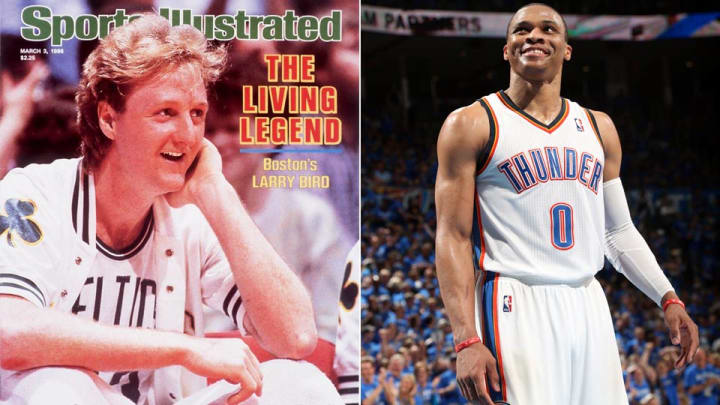
Editor's note: Twenty-nine years ago, Larry Bird was in his seventh season and fully immersed in his prime. When Celtics teammate Kevin McHale went down with an injury during the 1985-86 season, Bird took his game to even greater heights, accumulating incomprehensible numbers and devastating opponents with a brand of basketball the game had not previously seen. Fast forward 29 years and you'll find Russell Westbrook in his seventh season and fully immersed in his prime. When Thunder teammate Kevin Durant went down with an injury a few weeks ago, Westbrook took his game to new heights, accumulating four straight triple doubles and producing the same type of shock and awe Bird unleashed 29 years ago. Below is Jack McCallum's cover story from March 3, 1986 titled, "As Nearly Perfect As You Can Get." Replace Bird's name with Westbrook's and the feature might as well be about him.
There has never been a basketball player quite like the Celtics' Larry Joe Bird, in whom talent and tenacity rage a daily wire-to-wire battle for supremacy. Owing to the extraordinary importance of the giant pivotman in the game, it is probably impossible to declare that, in his seventh season, the 6'9", 220-pound Bird, a forward, is greater than Bill Russell, Wilt Chamberlain or Kareem Abdul-Jabbar—that is, the greatest player of all time. Or maybe it isn't.
"Before Bird I used to vacillate," says Bob Cousy, now a Celtics broadcaster. "The question didn't seem relevant. But Bird came along with all the skills, all the things a basketball player has to do. I think he's the greatest." Chimes in Milwaukee Bucks coach Don Nelson, "He's the best player ever to play the game." And there comes this weighty word from Westwood. "I've always considered Oscar Robertson to be the best player in the game," says John Wooden. "Now I'm not so sure that Larry Bird isn't." Even Laker general manager Jerry West, who refuses to compare players from different eras, says of Bird, "He is as nearly perfect as you can get in almost every phase of basketball."
• MORE SI VAULT: 60 years, 60 iconic stories from Sports Illustrated
Bird's play over the recent weeks has revealed an athlete at the height of his powers. When Kevin McHale went down with a heel injury, Bird just gritted his teeth, stooped and hefted McHale's load to his shoulders. In the Celtics' eight games since the All-Star break, Bird has averaged 30.8 points, 13.1 rebounds and 7.8 assists. But those are only numbers, and numbers don't necessarily provide a true picture when one is comparing players from different eras. "The one thing you have to avoid when you talk about Bird is statistics," says Red Auerbach. "It's his presence, the total way he commands attention on the court, that counts." Indeed, Bird reserves a spot in his personal hell (a place with no basketball courts) for the guy who plays with one eye on the stat sheet. "And there are a lot of them in this league," he says. "We've even had some here."
Inasmuch as the Celtics, with a best-in-the-league record of 43-11, have hardly missed a beat without McHale, Bird has to be the leading contender for his third straight MVP award, an accomplishment achieved in the NBA by only Russell and Chamberlain. Bird can probably count on Jack Ramsay's vote. After Bird struck for 47 points (including the game winner in overtime), 14 rebounds and 11 assists at Portland on Feb. 14, the Trail Blazer coach, a man not given to overstatement, called him "the greatest clutch player of all time." Five nights later, after Bird ravaged Golden State for 36 points, 12 rebounds and 11 assists, Warrior head man John Bach went scurrying for his dictionary. "Bird's a hermaphrodite," he said. Bird might raise an eyebrow at that word, but Bach meant, in Webster's sense, "something that is a combination of diverse elements."
"As an all-around player, there's never been anyone better," said Pacer coach George Irvine, the victim of a 30-11-12 Bird line Sunday night (his sixth triple double of the season). "A unique phenomenon," says San Antonio veteran Artis Gilmore of Bird.
GALLERY: Rare photos of Larry Bird
Rare Photos of Larry Bird
Larry Bird and Indiana State cheerleaders
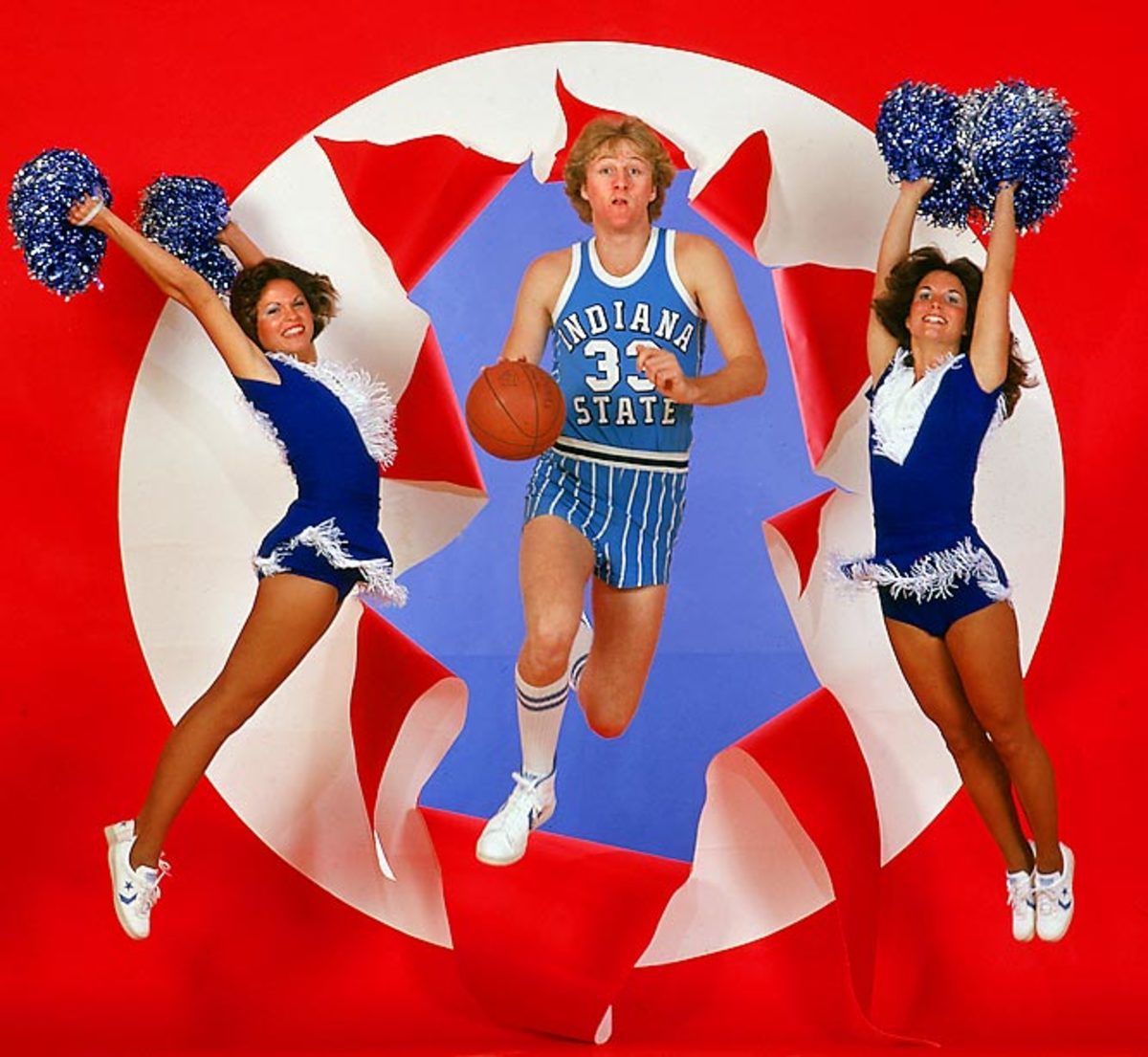
In June 2012, Larry Bird stepped down as president of the Indiana Pacers. A month earlier, he was named the league's top GM and became the first person to win MVP, Coach of the Year and Executive of the Year. As Bird prepares for the next stage in his life, SI.com takes a look at some rare photos of "The Hick from French Lick," including this shot of him and the Indiana State cheerleaders.
Larry Bird
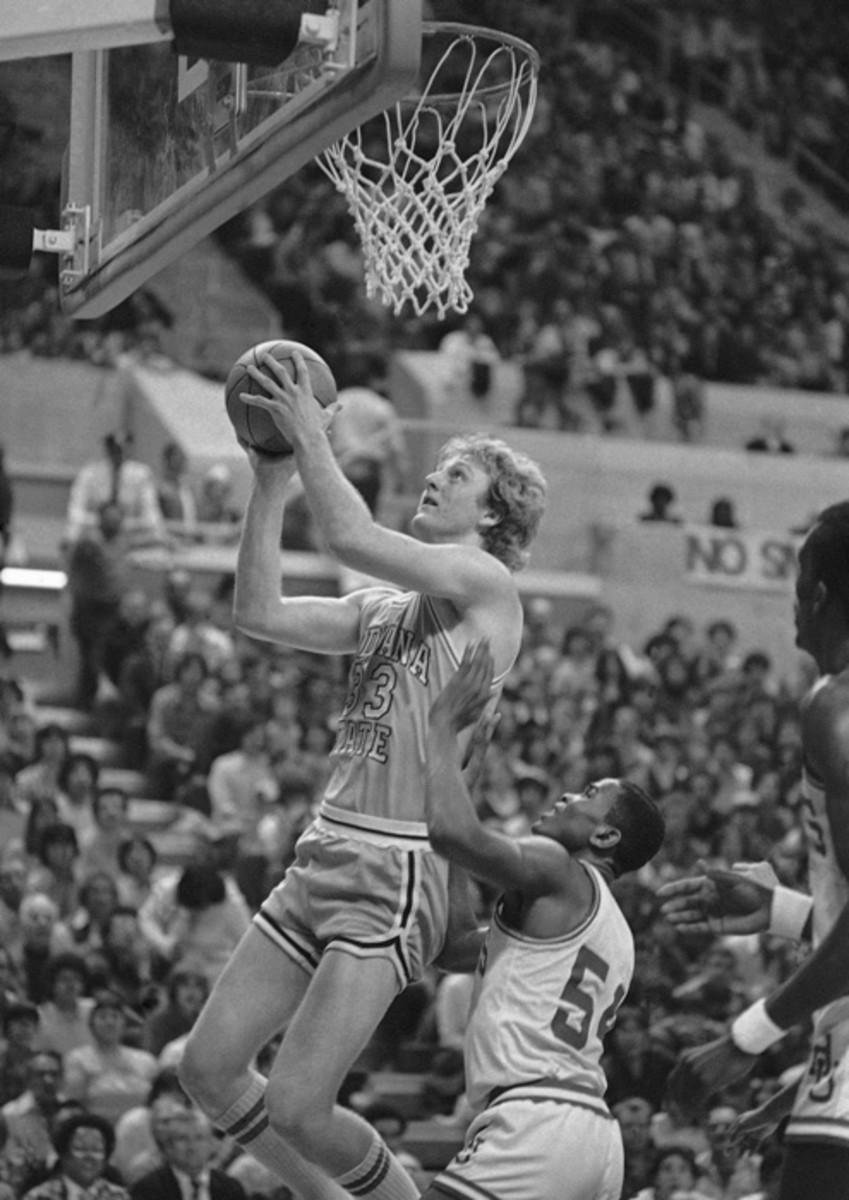
Bird goes to the basket as Rutgers' Kelvin Troy defends during a NIT quarterfinal game.
Larry Bird and Erskine Robinson
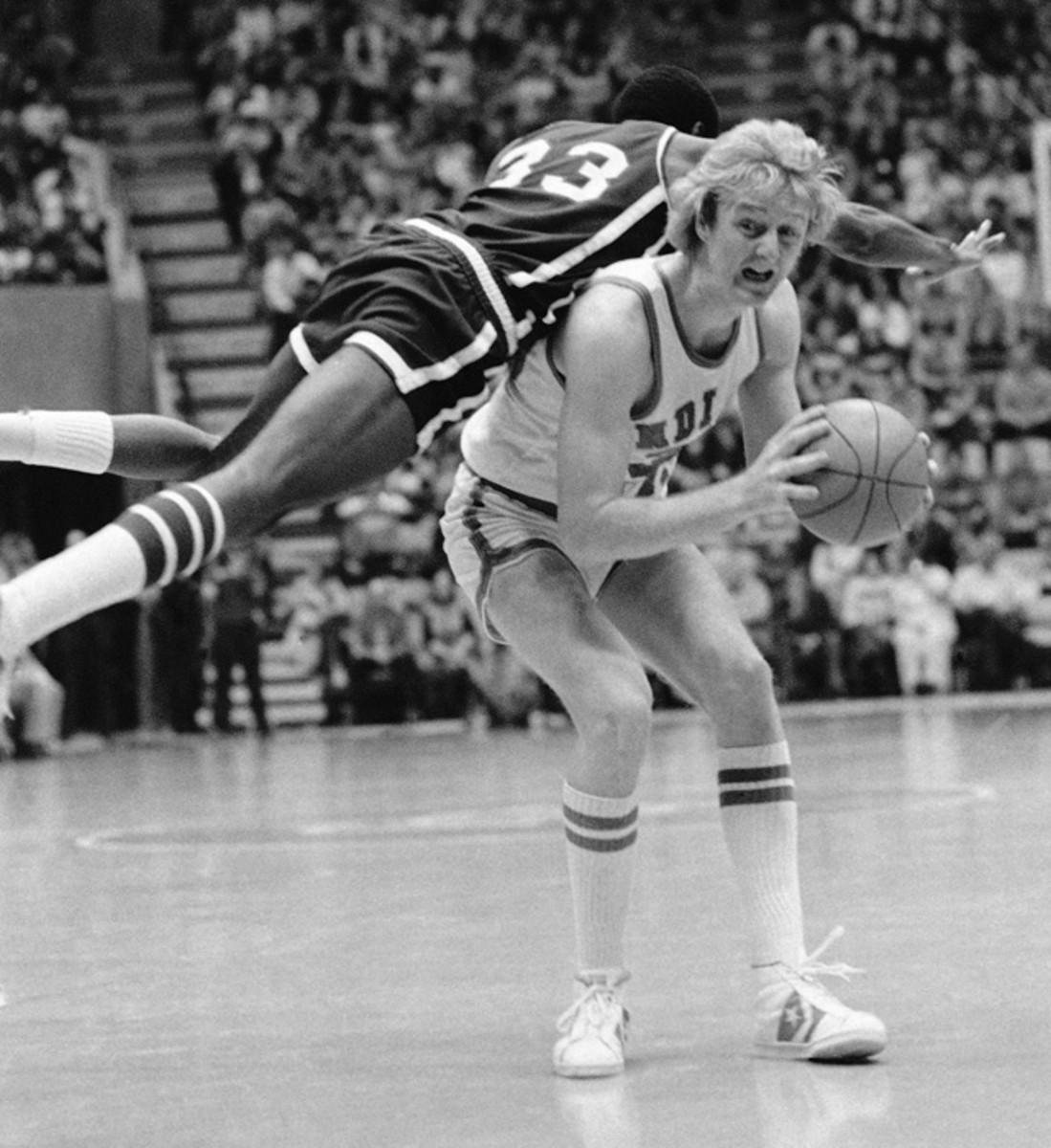
The All-American draws a foul from West Texas State's Erskine Robinson during the Missouri Valley Conference tournament.
Alex Gilbert, Larry Bird and Carl Nicks
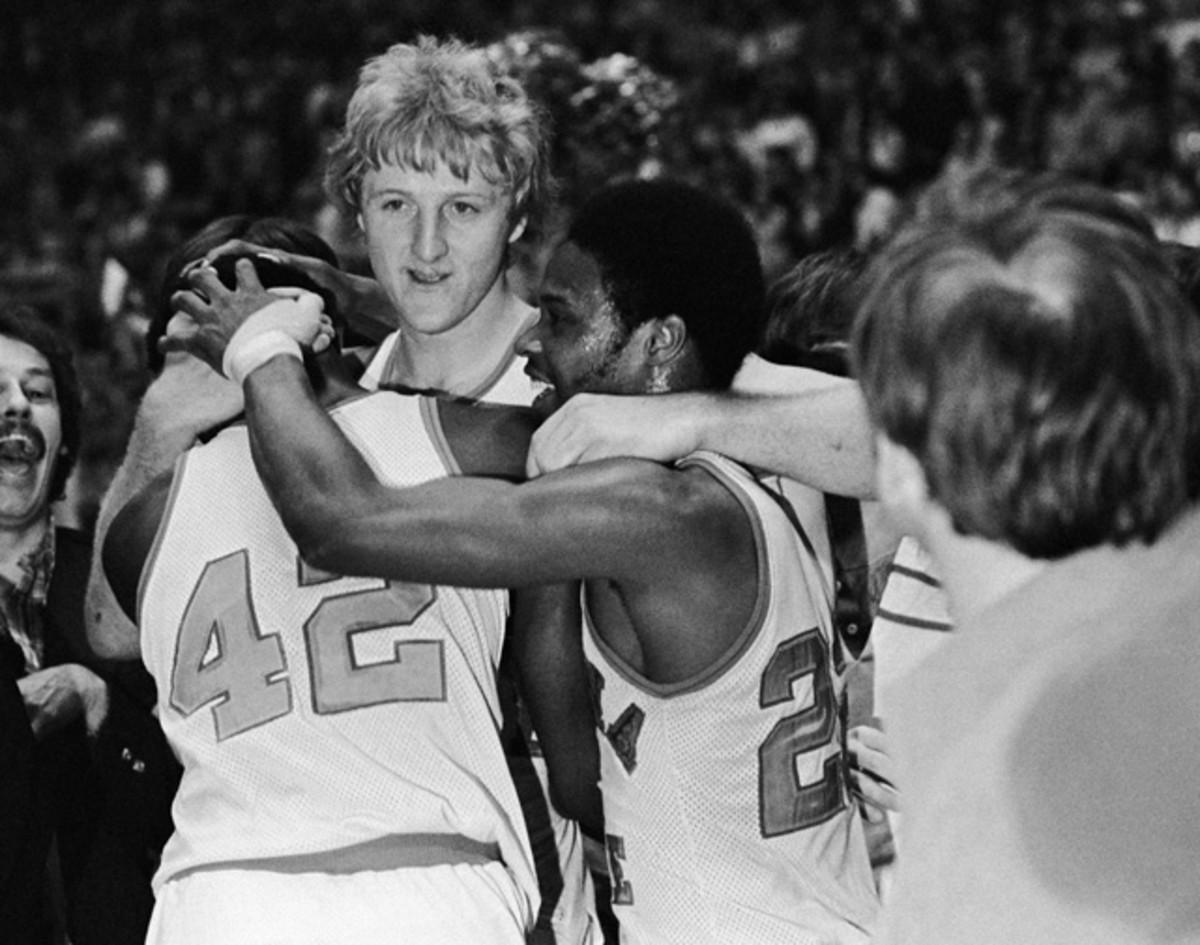
Bird hugs teammates Alex Gilbert (left) and Carl Nicks after Indiana State beat Arkansas 73-71 to advance to the Final Four.
Larry Bird

Bird takes a break on the bench during a home game. The Sycamores were undefeated and the No. 1 team in the nation at this point in Bird's senior season.
Magic Johnson and Larry Bird
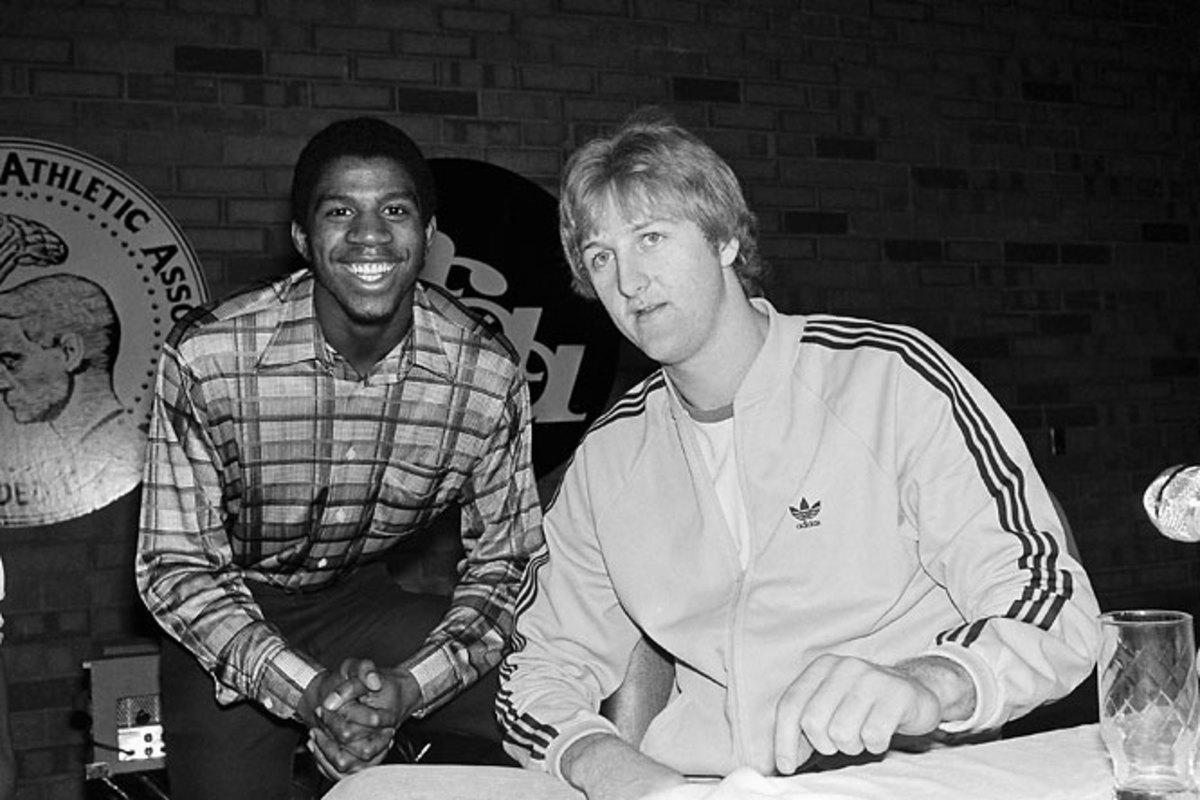
Bird and longtime rival Magic Johnson pose for a shot at the 1979 Final Four.
Larry Bird and Magic Johnson
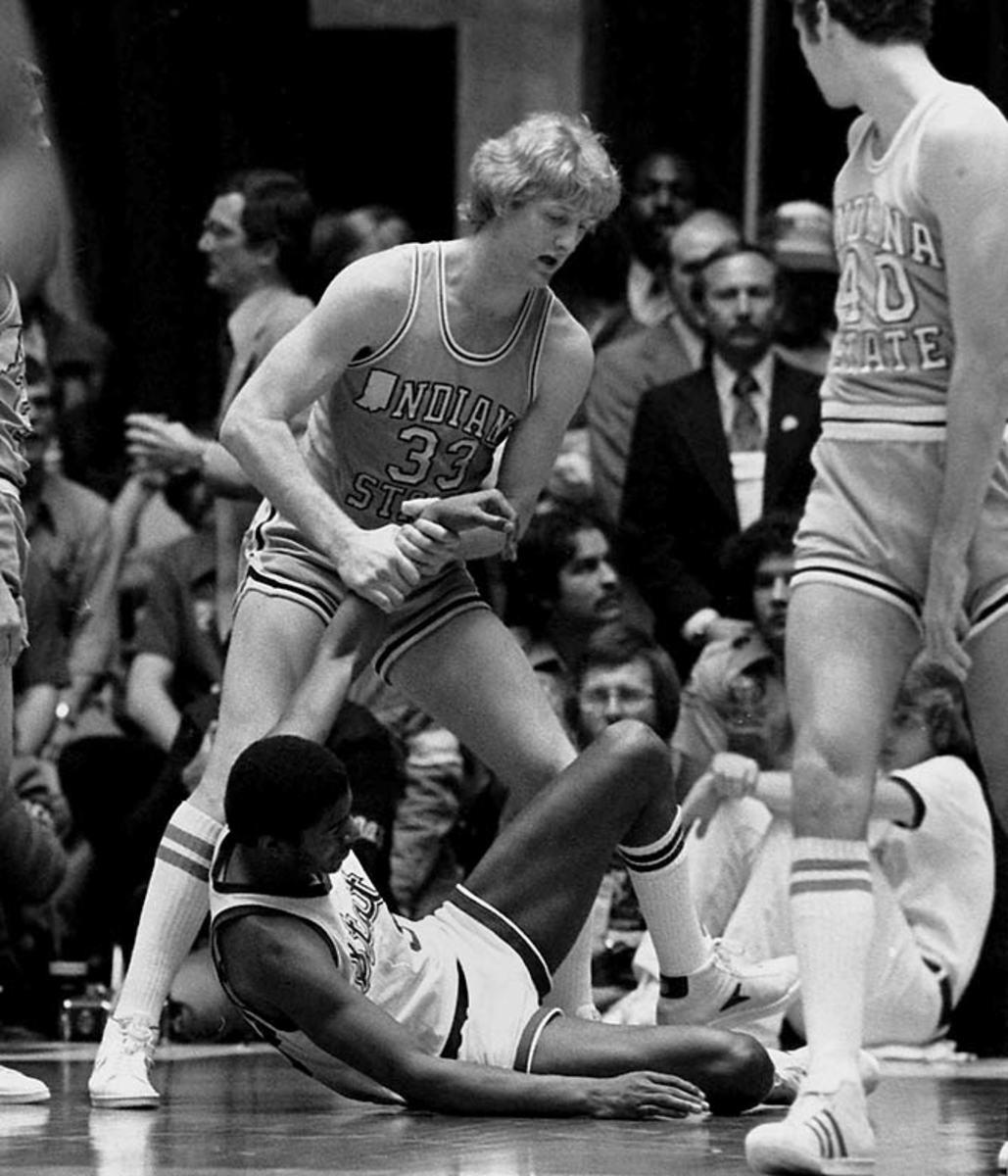
Bird gives Johnson a helping hand during the NCAA Championship game in Salt Lake City.
Larry Bird and Bill Hodges
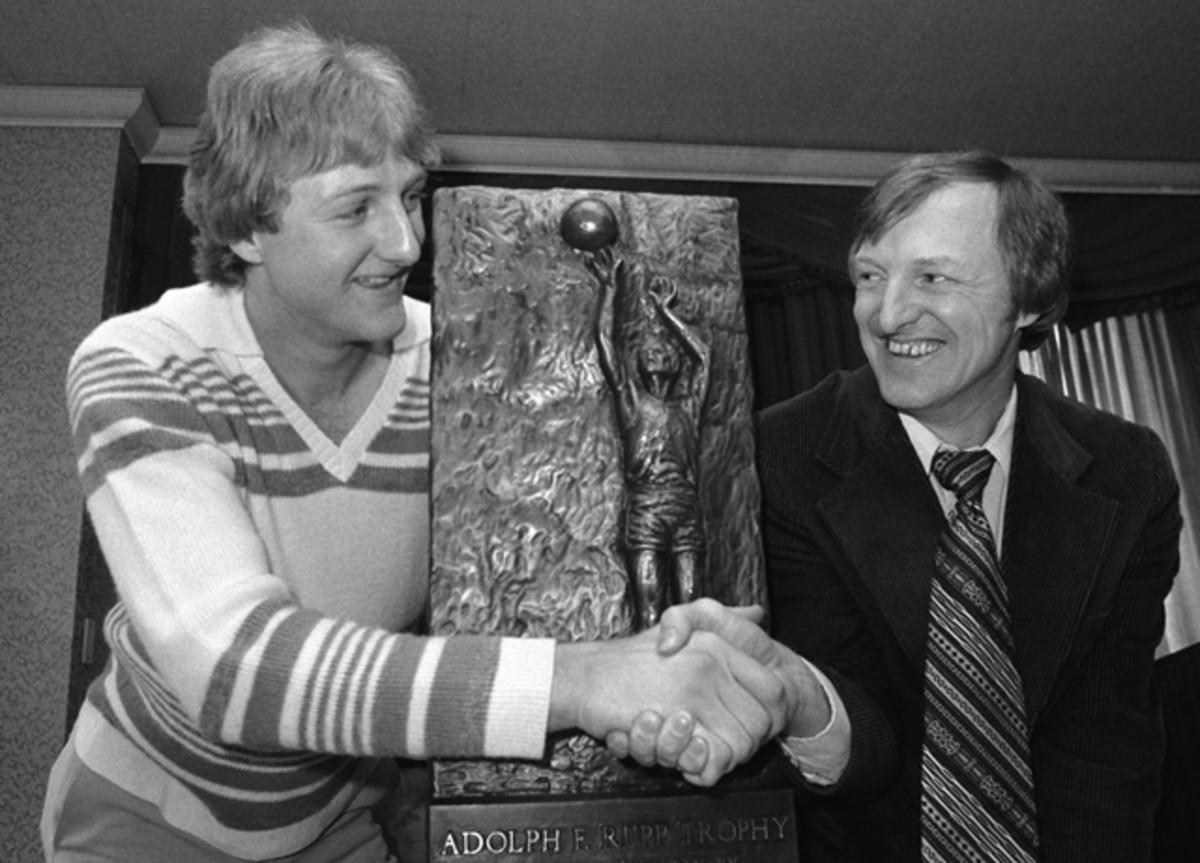
Bird and his coach shake hands in front of the Adolph Rupp trophy. Bird earned the Player of the Year award, while Hodges took Coach of the Year honors after losing only one game -- the national championship -- all season.
Larry Bird and Fredbird
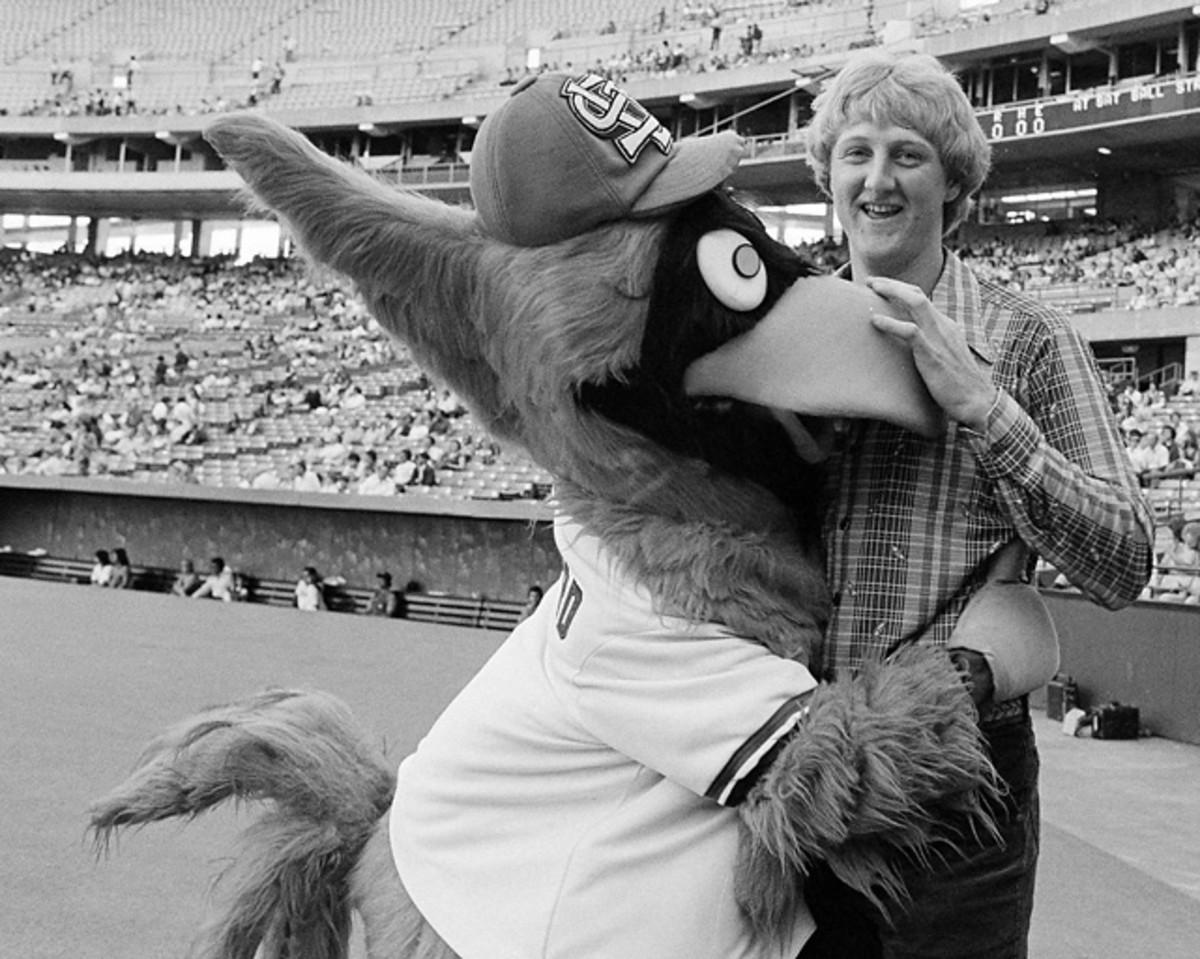
The college basketball player of the year gets a hug from the St. Louis Cardinals mascot before a June game at Busch Stadium. Bird threw out the first pitch.
Larry Bird and Bob Wolf
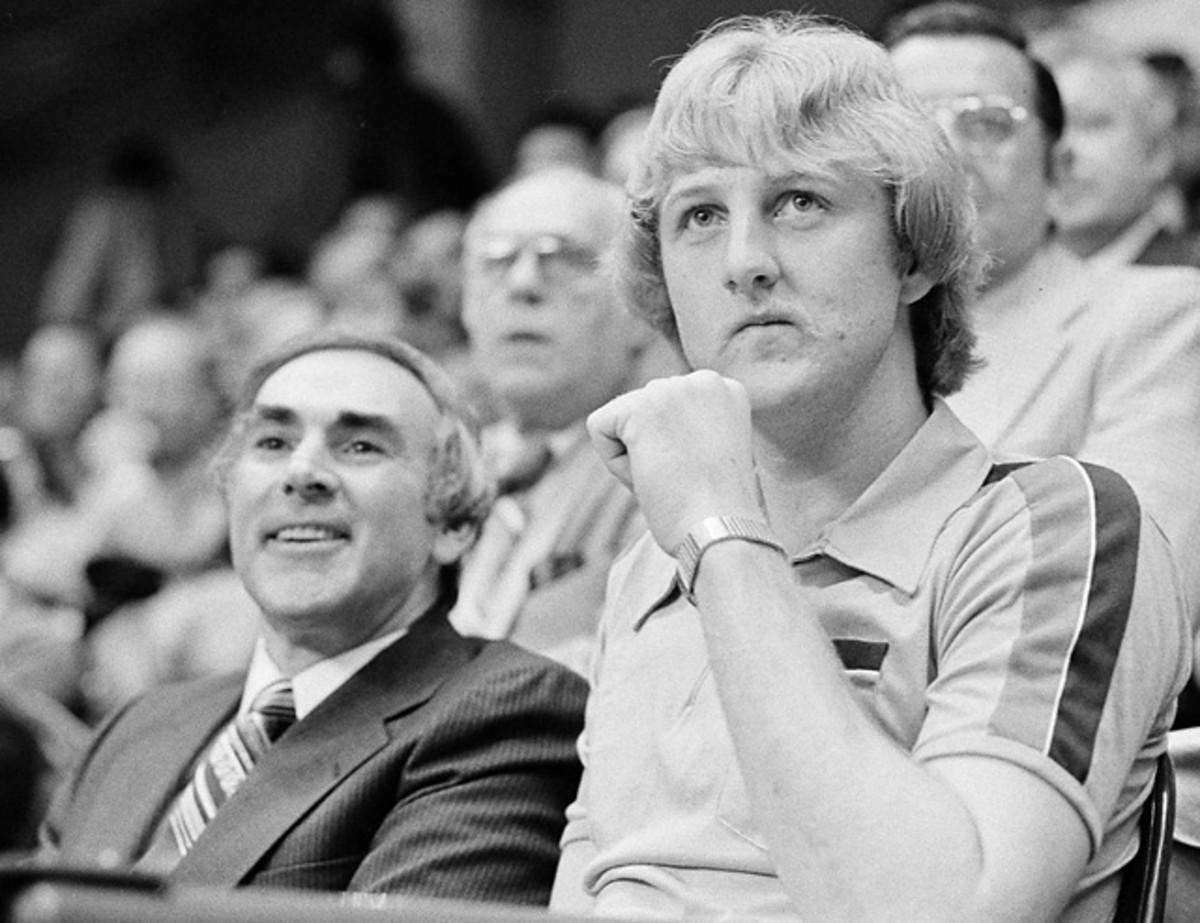
Less than two weeks after his Indiana State team fell to Michigan State in the national championship game, Bird takes in a Celtics game with his agent, Wolf.
Larry Bird and Red Auerbach
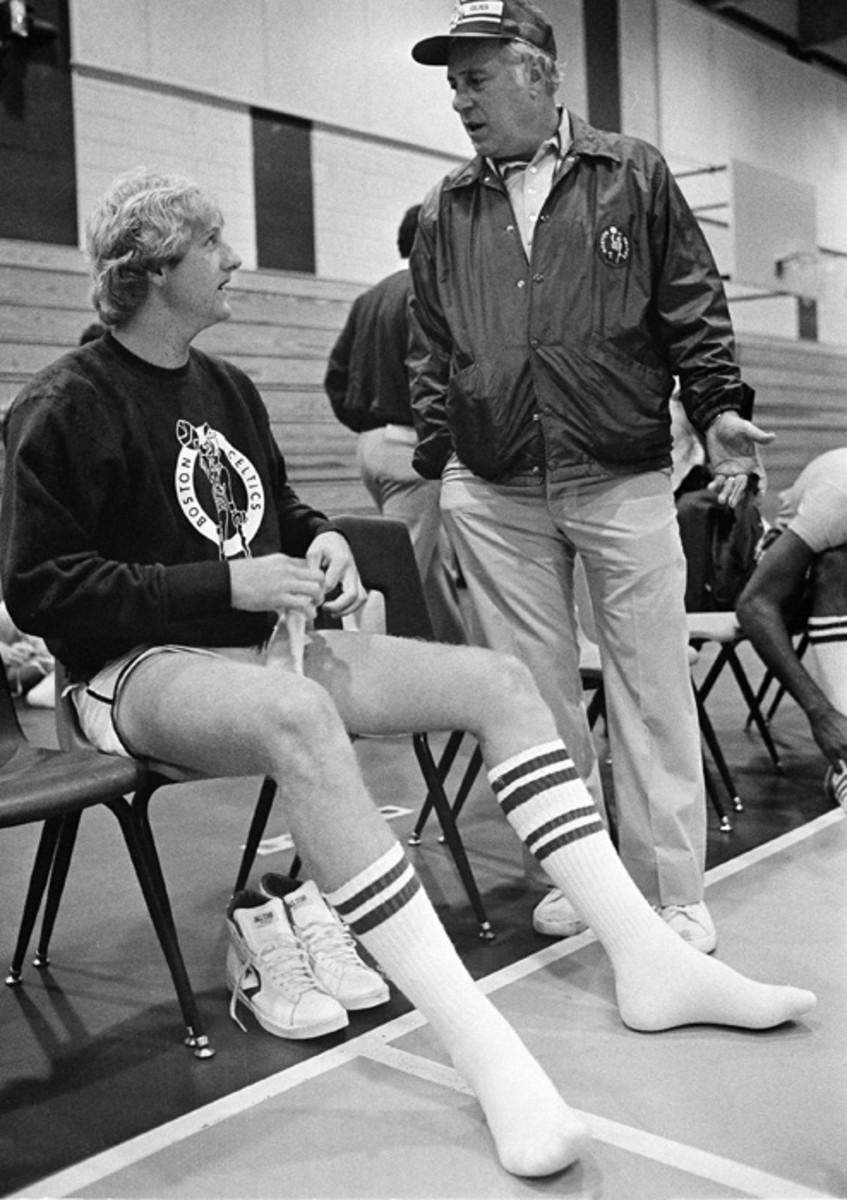
Bird talks with Celtics general manager Red Auerbach before the start of his rookie camp. He would win Rookie of the Year honors after averaging 21.3 points and 10.4 rebounds per game.
Larry Bird
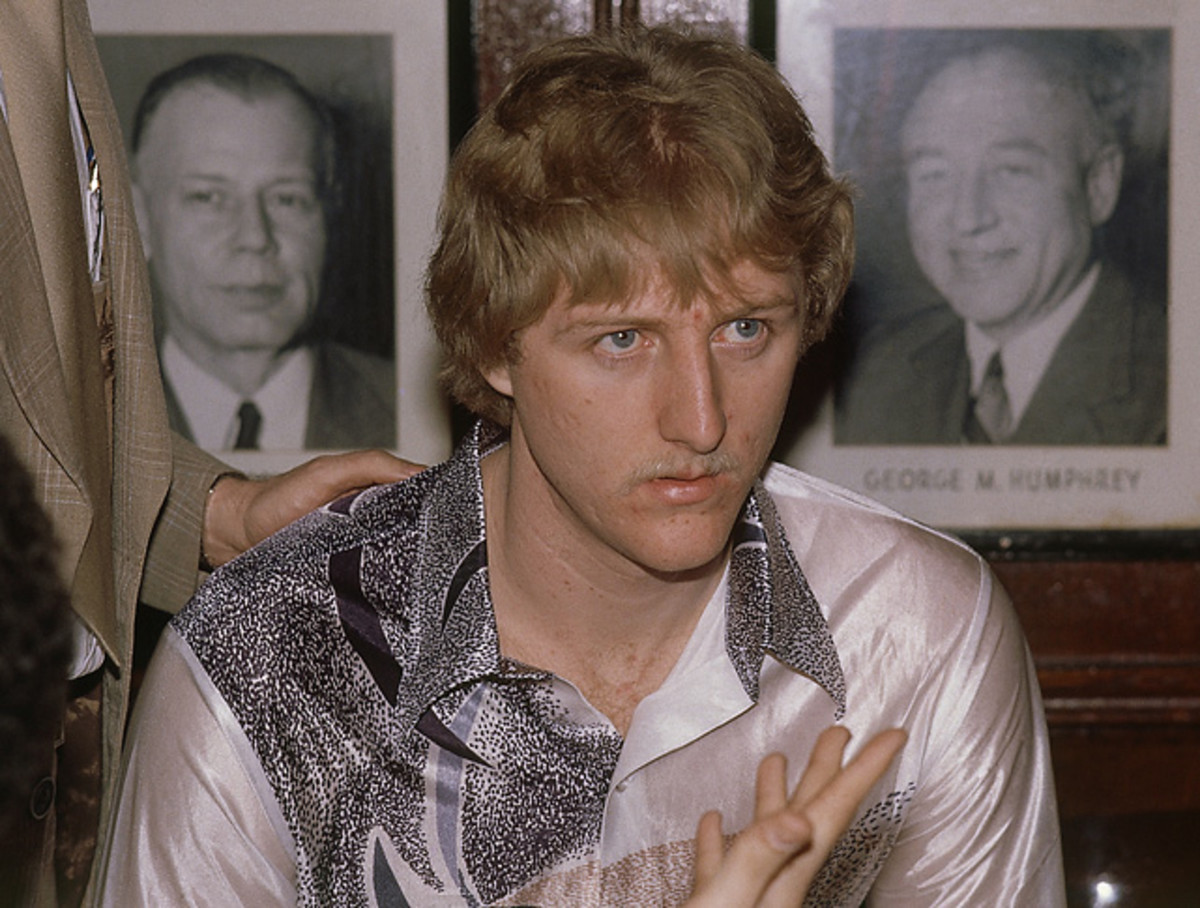
Bird wears a snazzy shirt to a dinner with Celtics brass.
Red Auerbach, Larry Bird and Bill Fitch
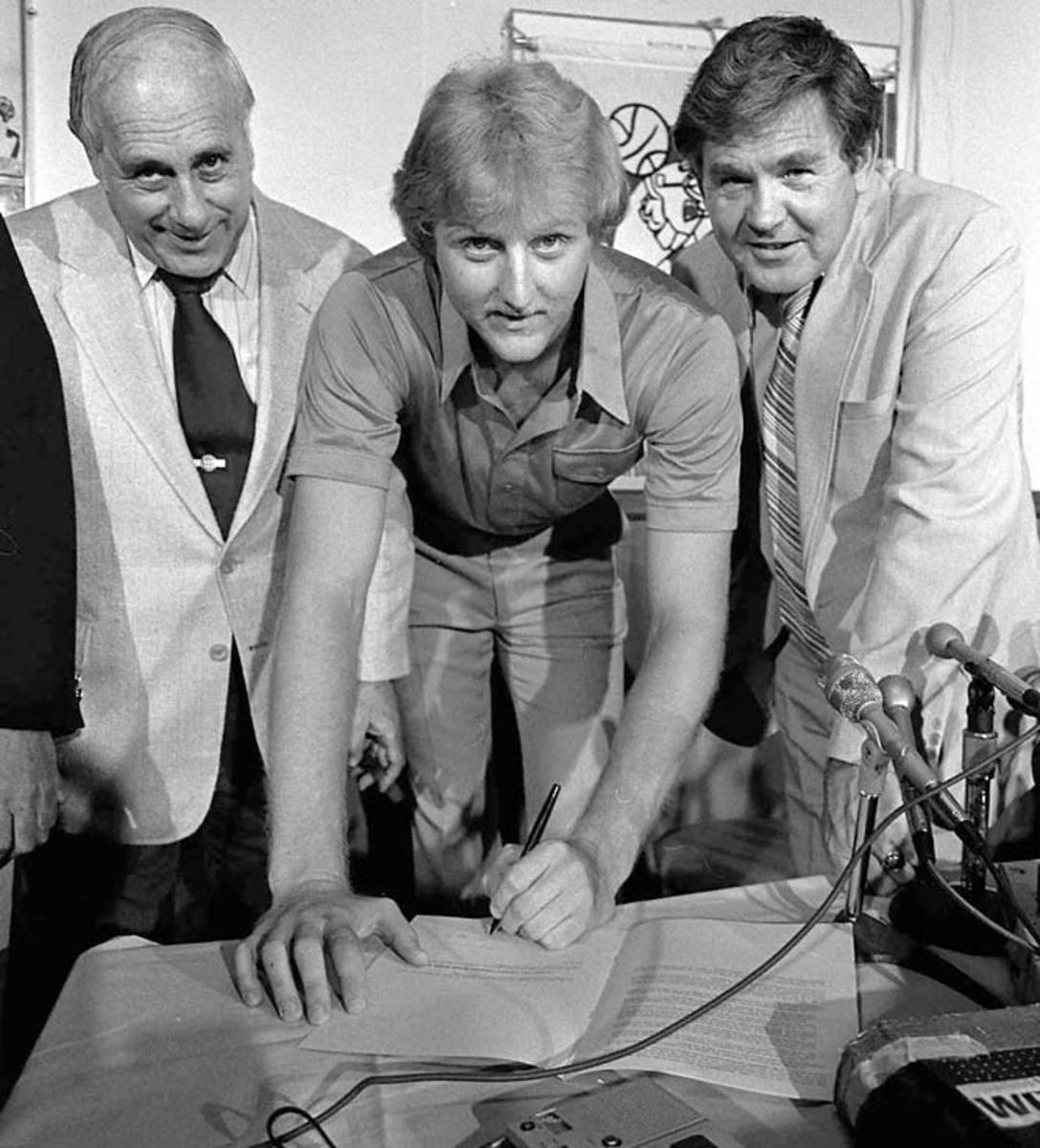
Bird became the richest rookie in sports history when he signed a five-year, $3.25 million contract in 1979. To Bird's left is Celtics President Red Auerbach and to his right is head coach Bill Fitch.
Larry Bird and Cedric Maxwell
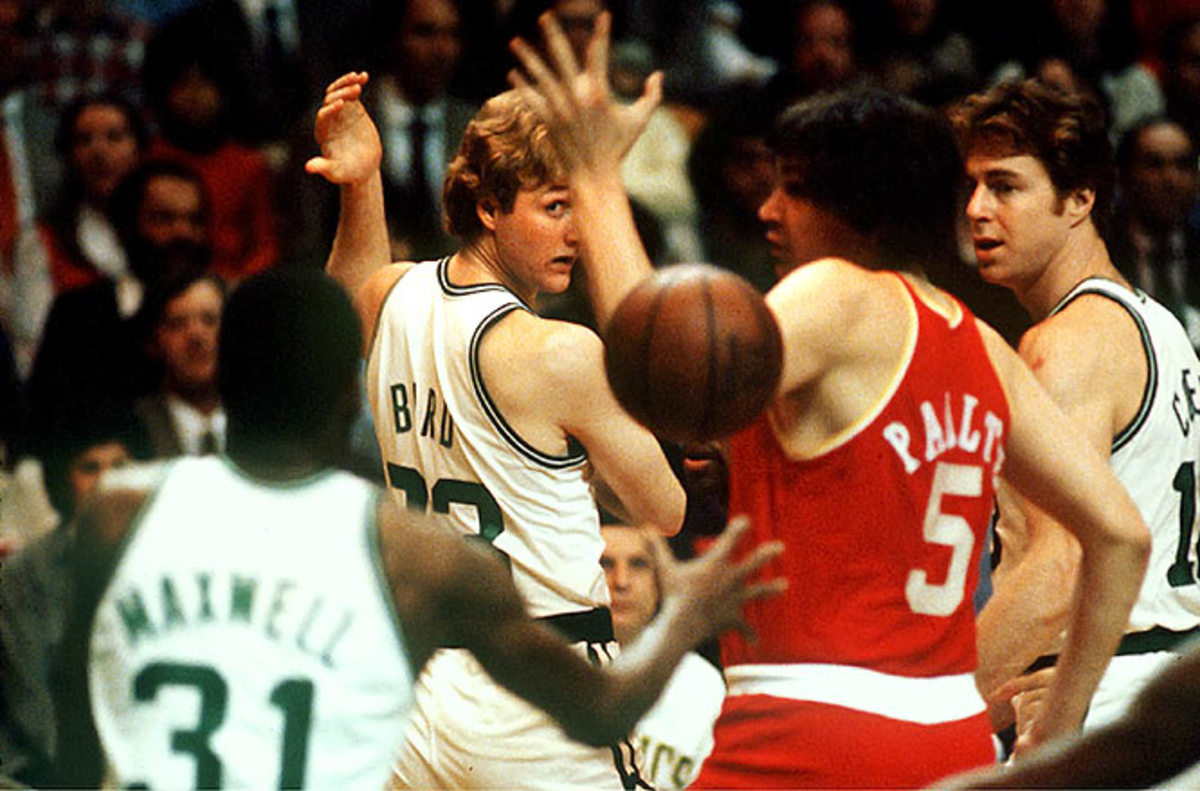
Bird tosses a pass behind his back to Cedric Maxwell during a game against the Rockets.
Bill Russell and Larry Bird
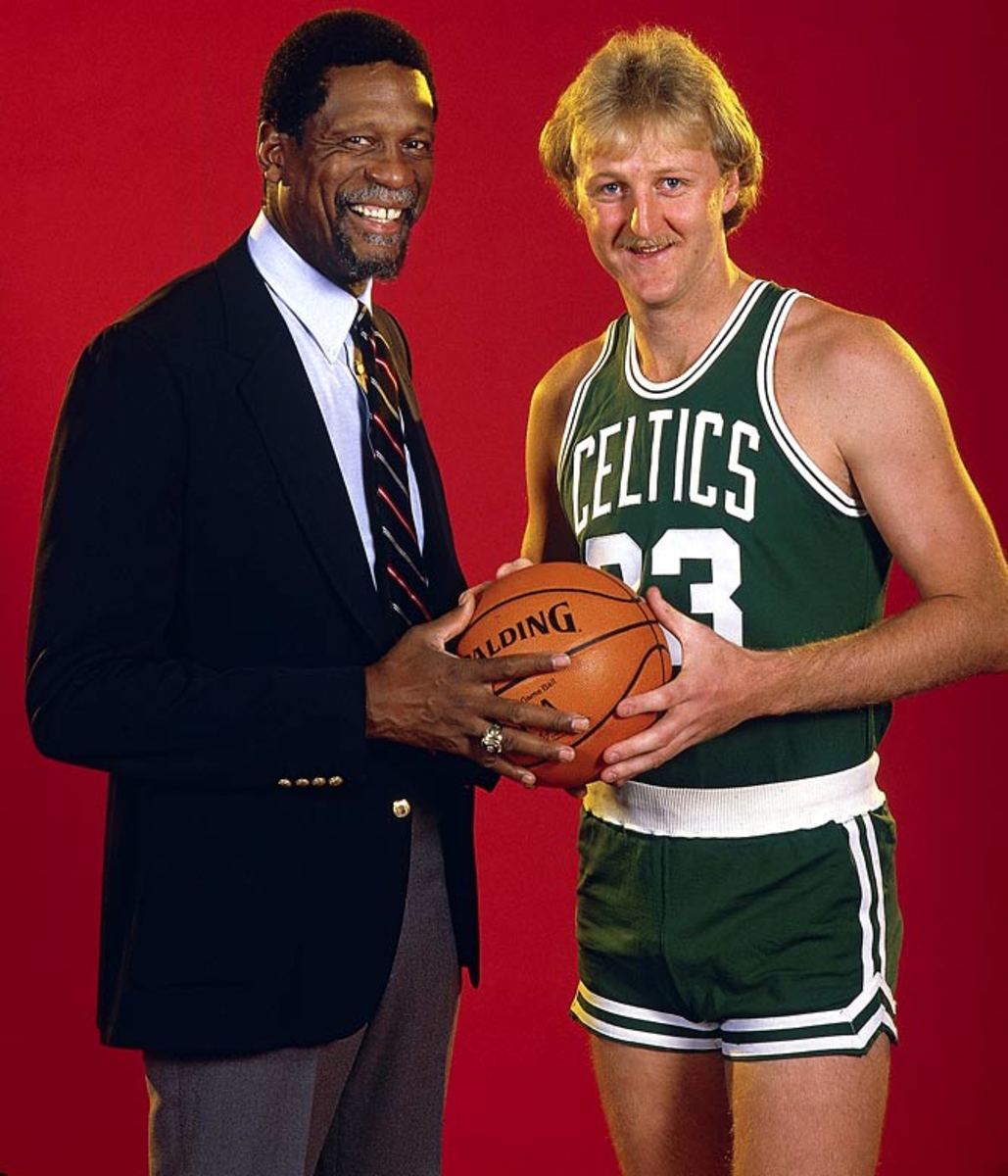
Bill Russell poses with Bird before a preseason game.
Larry Bird
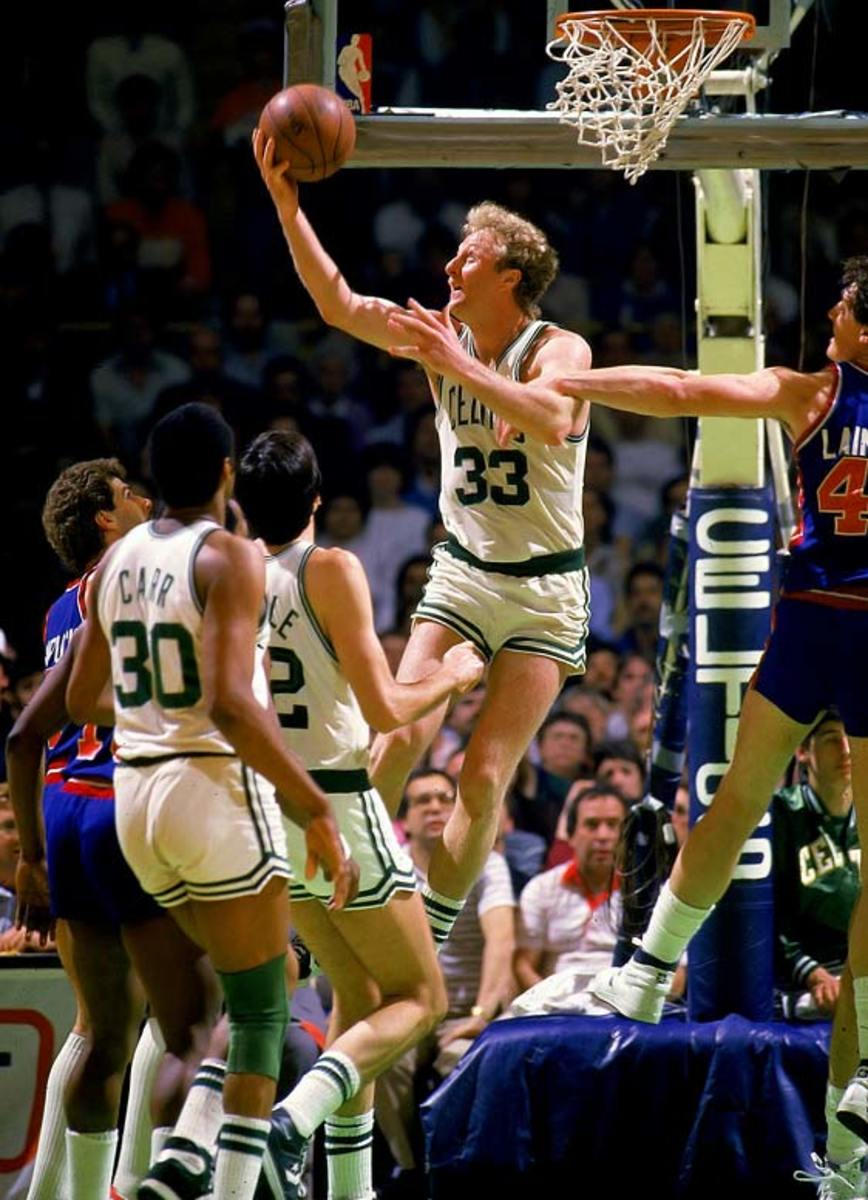
Bird converts on a reverse layup during a game against the Pistons.
Larry Bird

Bird stretches before a game against the Knicks.
Larry Bird and Red Auerbach

Bird and Celtics president Red Auerbach pose at the unveiling of a Leroy Nieman potrait of the Celtics star during his retirement ceremonies.
Larry Bird

Bird was featured on the cover of Frosted Mini-Wheats during the 1992 Olympics.
Red Auerbach, Bob Cousy, Larry Bird, Tom Heinsohn, John Havlicek
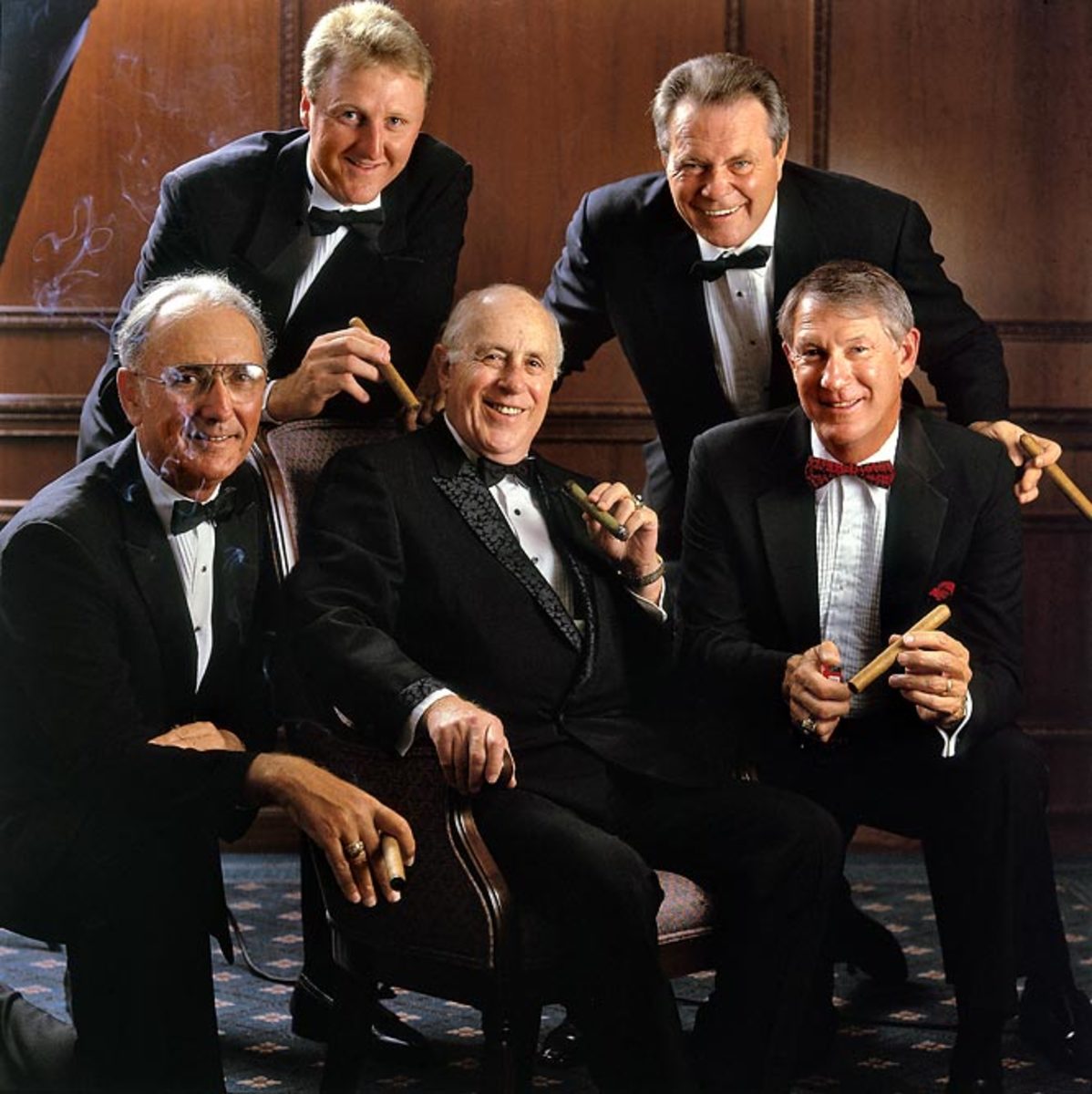
Boston Celtics celebrating Red Auerbach's 75th birthday.
Larry Bird

The Pacers' coach poses for an SI cover shoot.
Larry Bird, Isiah Thomas and Donnie Walsh
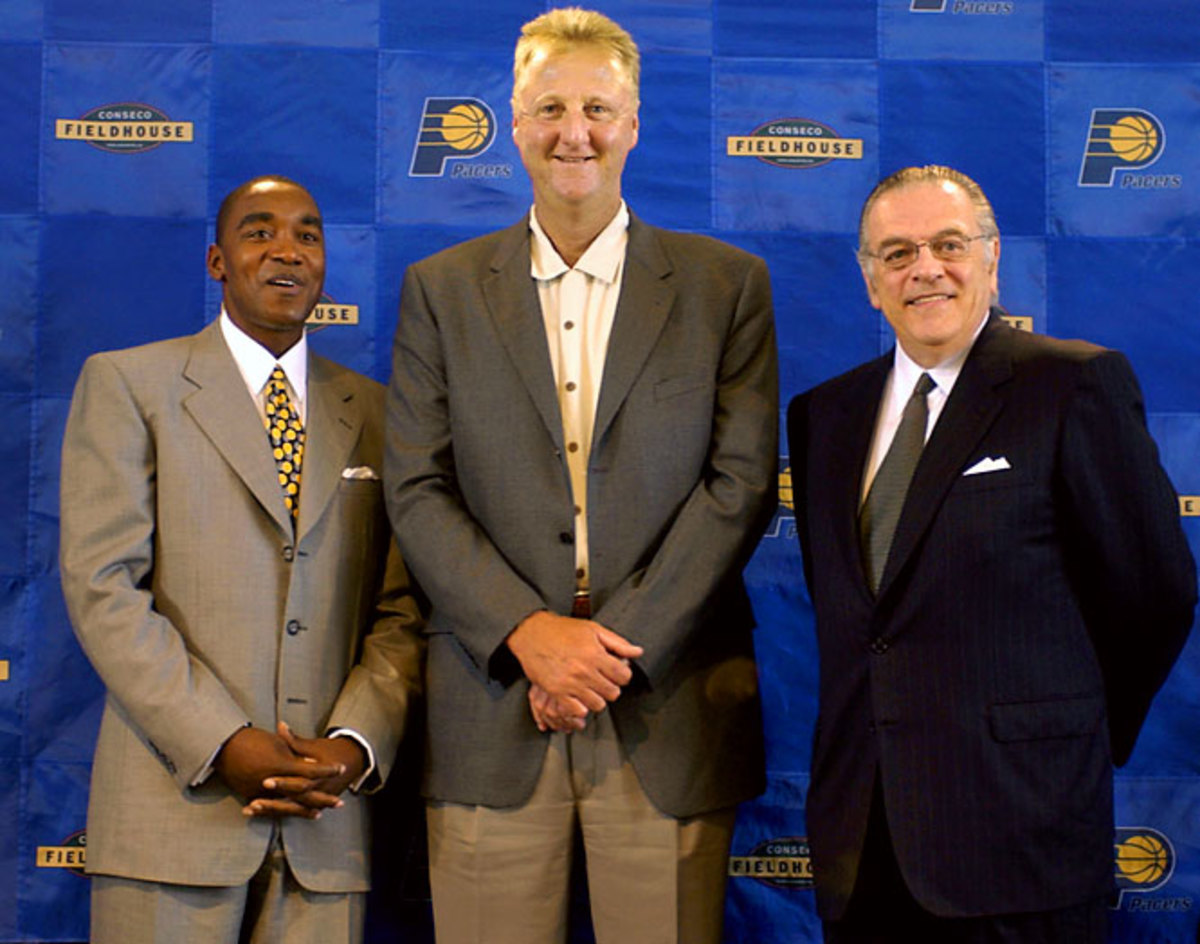
Bird stands with Pacers coach Isiah Thomas and CEO Donnie Walsh after being named president of basketball operations.
Jermaine O'Neal and Larry Bird
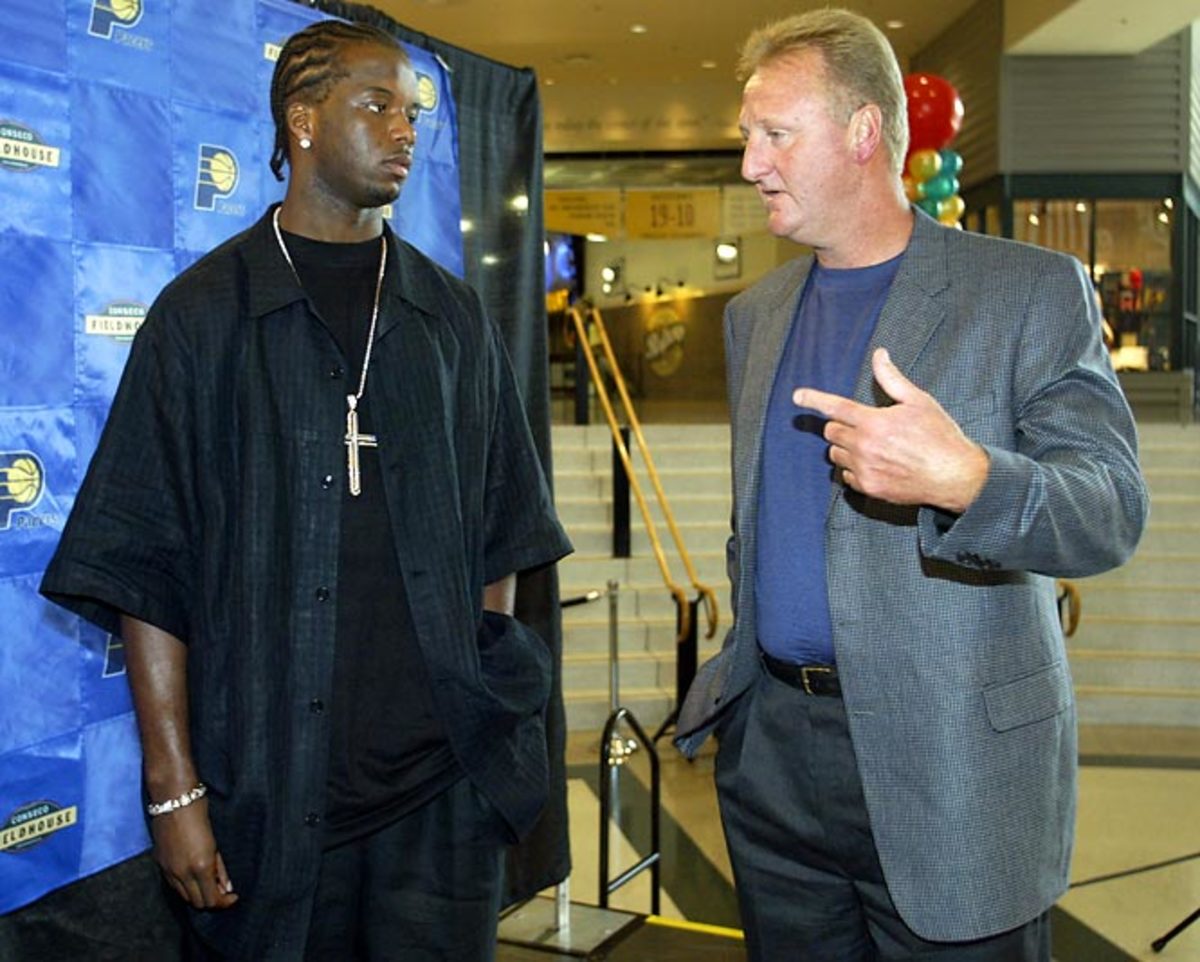
Jermaine O'Neal talks with Bird after the announcement of O'Neal's new seven-year contract.
Reggie Miller and Larry Bird
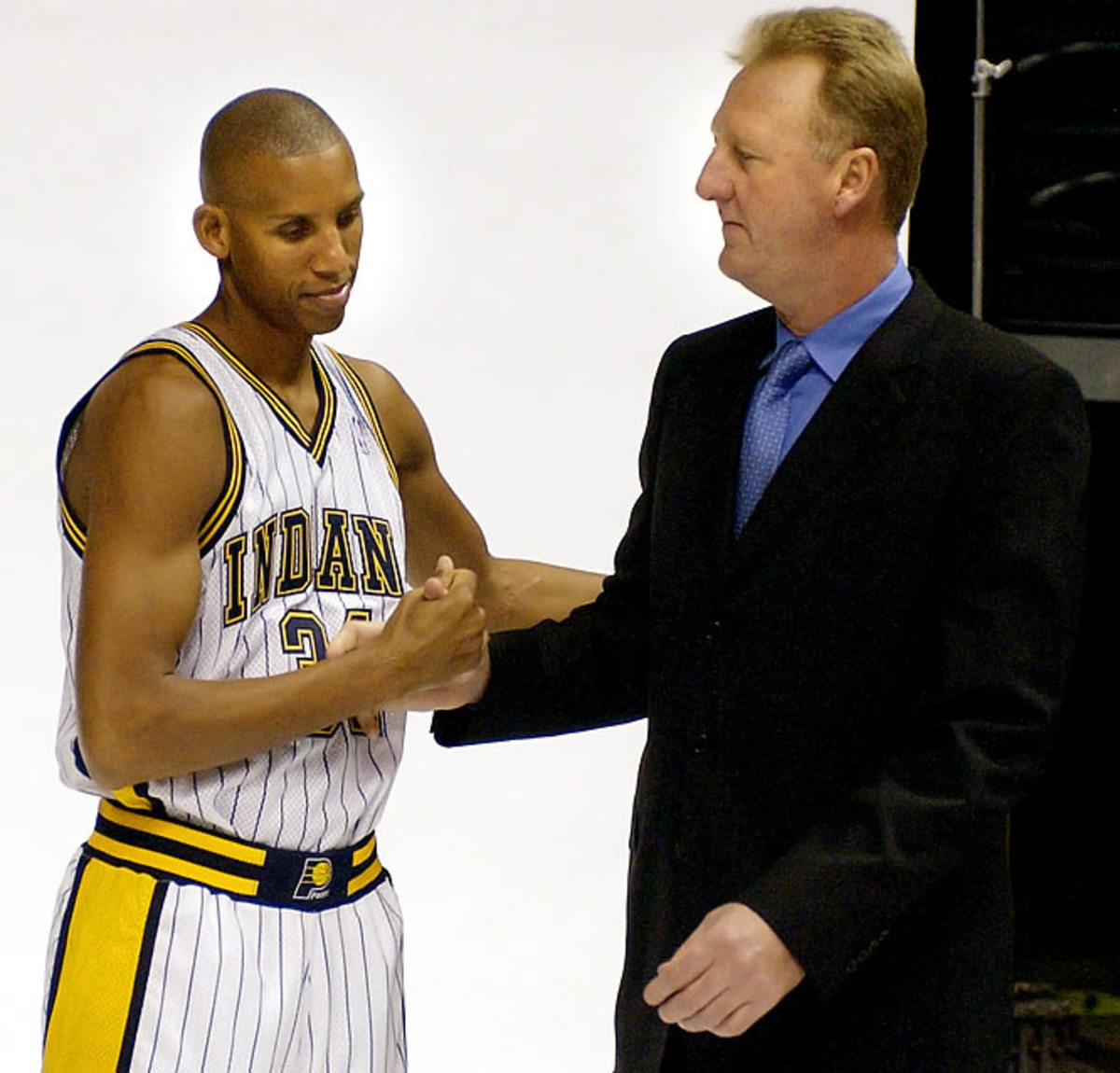
Reggie Miller greets Larry Bird during the Pacers' media day in Indianapolis.
Michael Phelps and Larry Bird
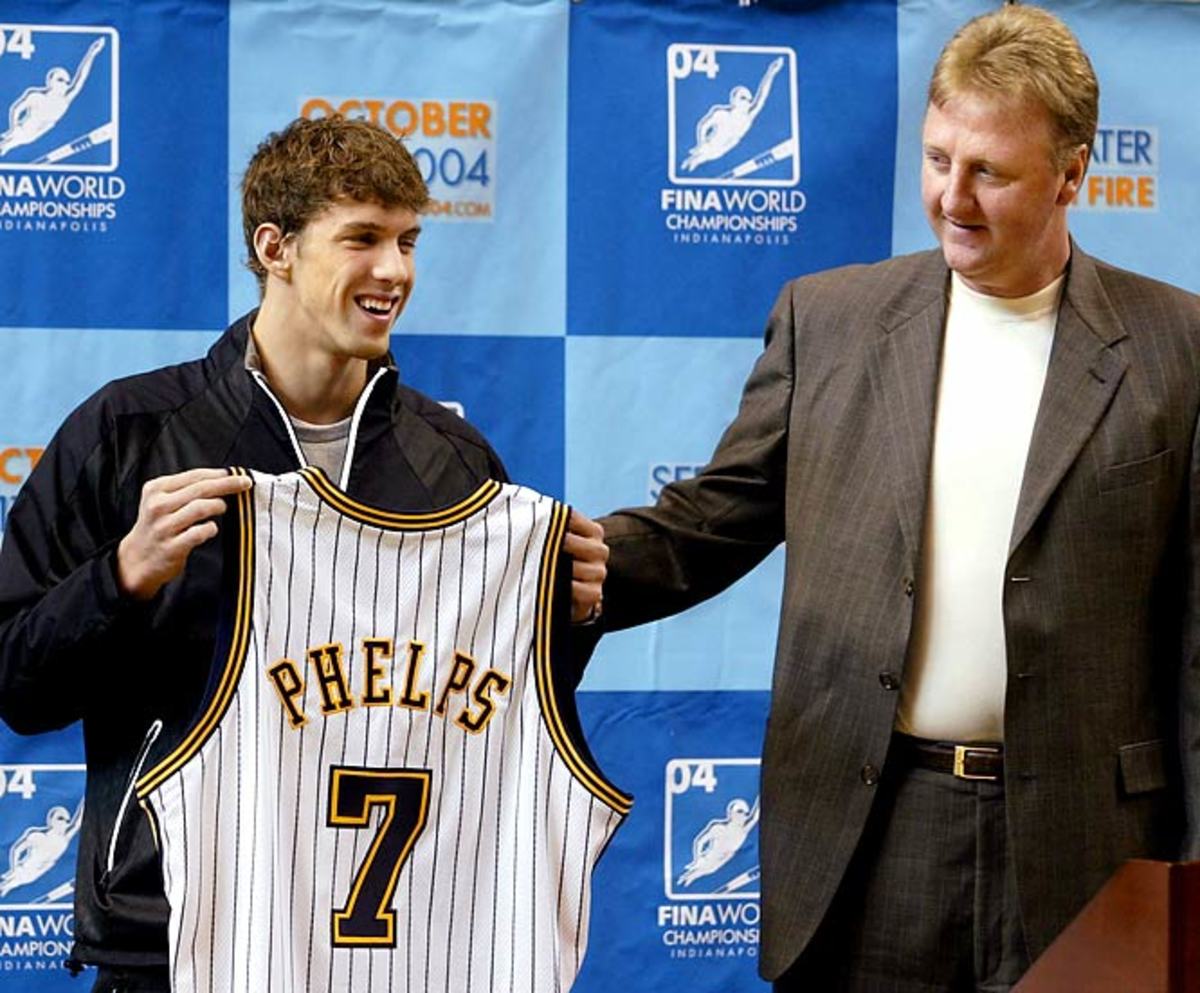
Bird presents Michael Phelps with a team jersey at Conseco Fieldhouse. The No. 7 on the jersey represents the number of gold medals Phelps was expected to compete for in the 2004 Olympics.
Larry Bird and Ron Artest
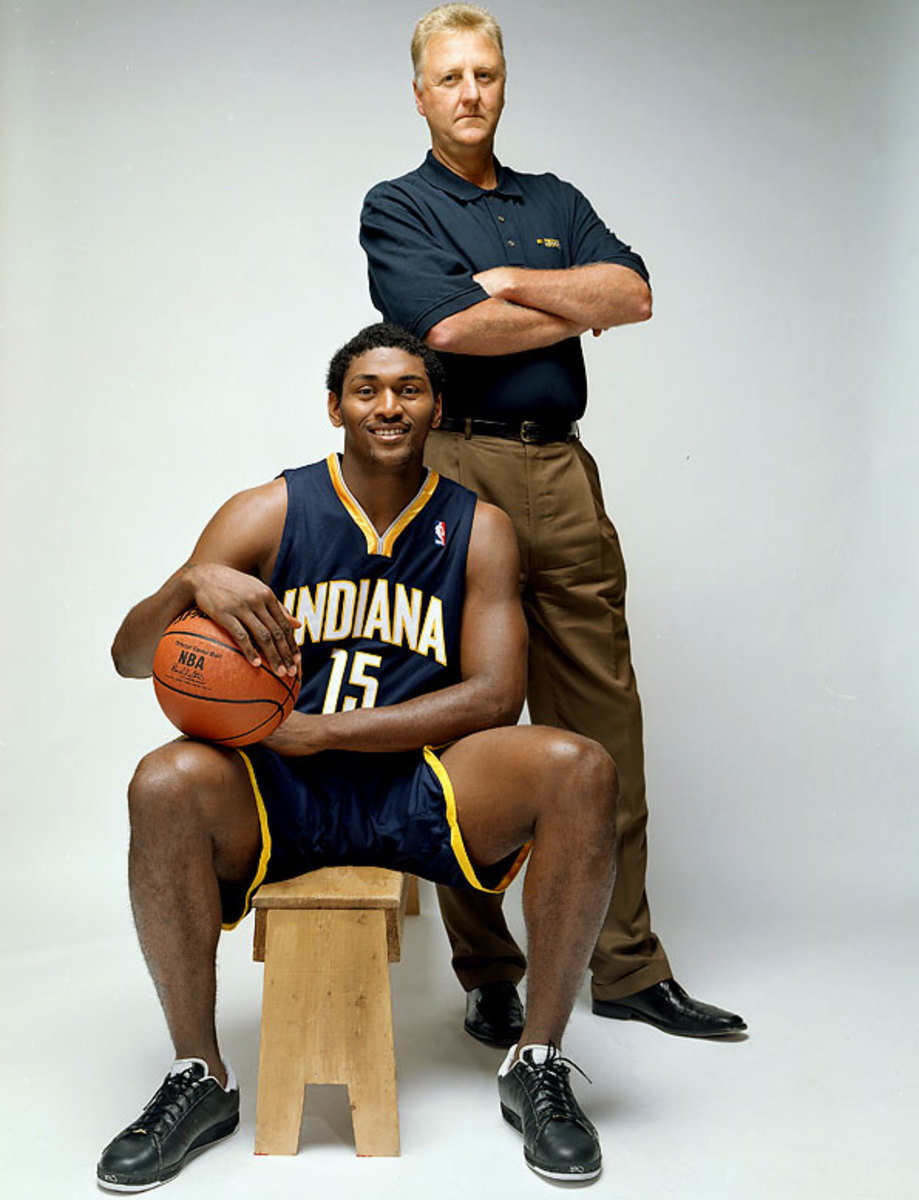
Bird poses with Ron Artest at an SI photo shoot for the 2005-06 NBA preview.
Larry Bird's Converse
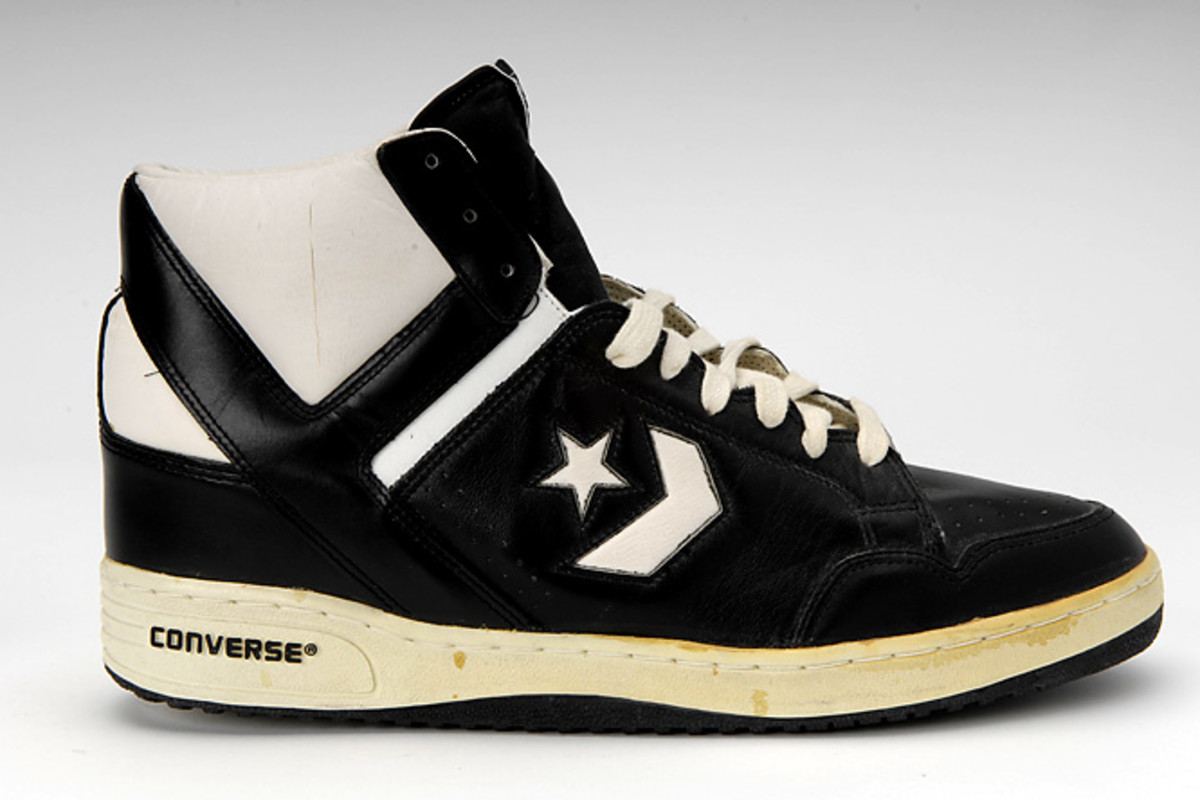
This is the Converse Weapon worn by Larry Bird during the 1986 season. It is on display at the Basketball Hall of Fame.
Larry Bird

Bird helps gather food for needy families at the Indiana Pacers Academy.
Larry Bird

Bird shows off his guns during a pre-draft camp in Lake Buena Vista, Fla.
Larry Bird and Magic Johnson

Magic Johnson and Larry Bird share a laugh at a news conference before the 2009 NCAA championship game between Michigan State and North Carolina.
Kevin Daniels, Magic Johnson, Larry Bird and Tug Coker
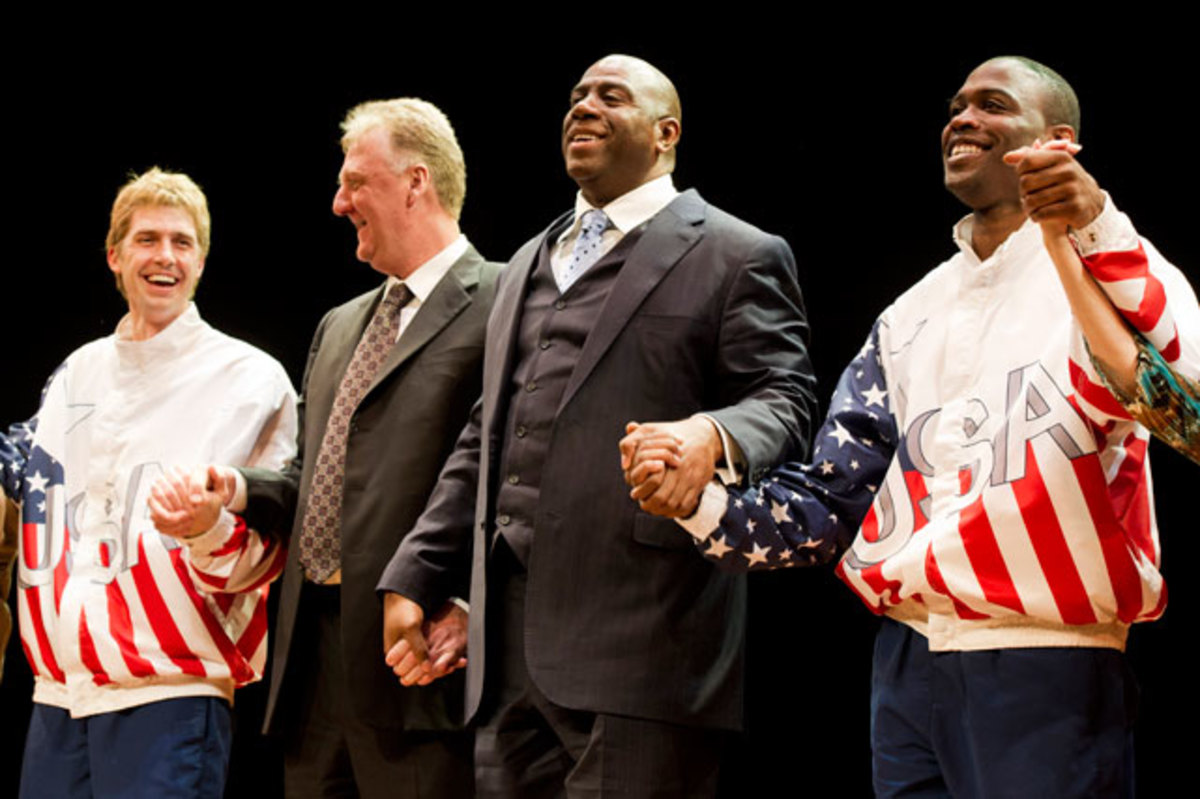
Kevin Daniels and Tug Coker, who appeared as Larry Bird and Magic Johnson in the Broadway play Magic/Bird , take a curtain call with the two Hall of Famers during the play's opening night peformance.
Stu Jackson and Larry Bird
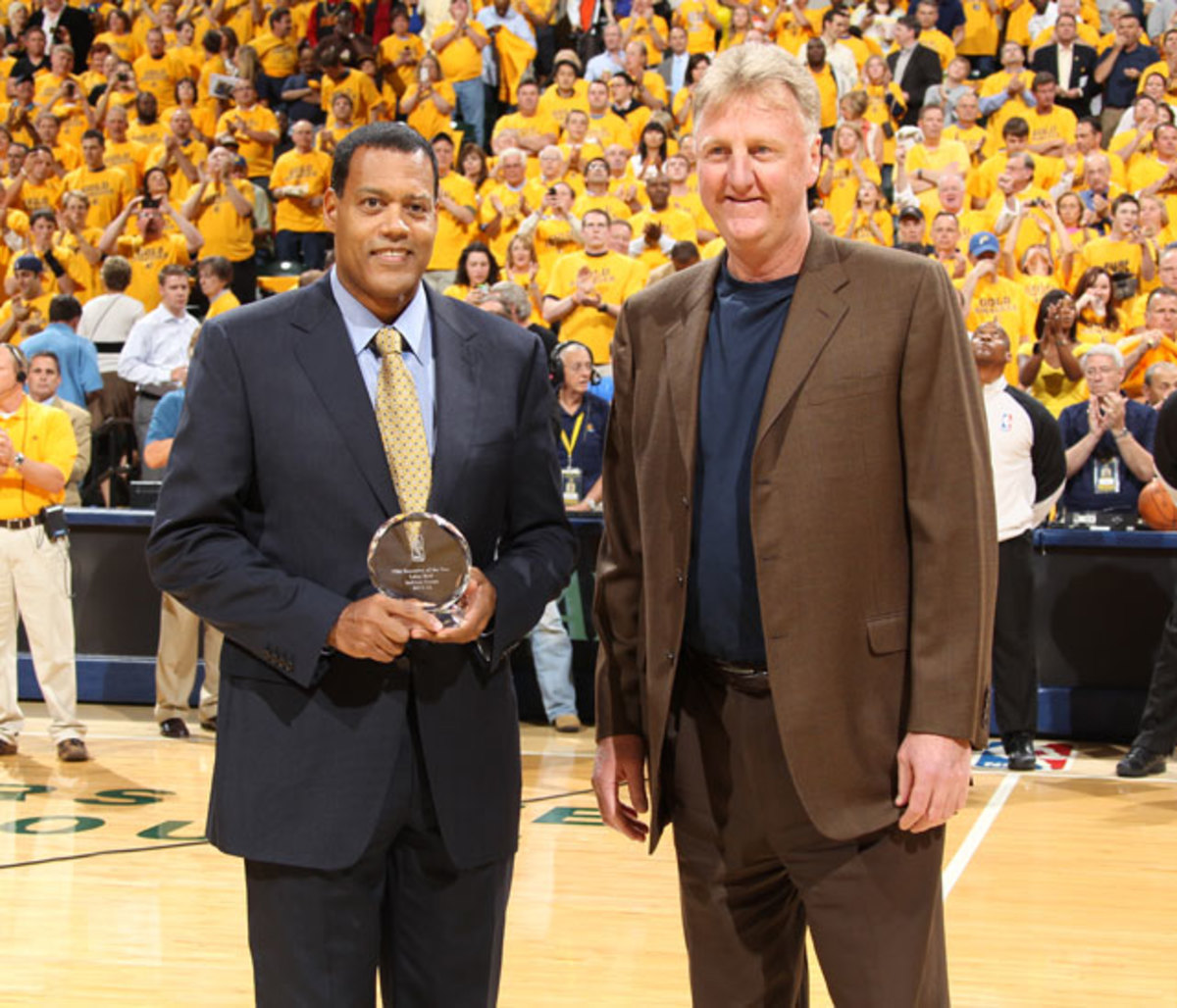
Stu Jackson presents Bird with the NBA Executive of the Year Award before Game 3 of the Eastern Conference semifinals between the Pacers and Heat.
If Auerbach will turn his head for a moment, it can be noted that Bird is the only player listed among the season leaders in five different statistical categories. They include, of course, scoring (fifth at 25.3) and rebounding (ninth at 10.1), but these don't begin to address his uniqueness. He's the third-leading free-throw shooter at 89.3% and the only full-time player in the top six. A man's free-throw accuracy tends to decrease with playing time, but that doesn't hold for the indefatigable Bird, who said last week, "I have only one real goal in this league: to play every minute of every single game." (He averages 38.9 minutes and hasn't missed a game this season; in the preseason, Bird's back had been so bad that he had "almost counted out the whole year.") The top three-point shooters in the league are small, jump-shooting guards...except for Bird and Dallas forward Dale Ellis. Lightning-quick black athletes—such as Alvin Robertson, Clyde Drexler, Maurice Cheeks, Isiah Thomas—are the league leaders in steals...except for Bird, in eighth place with 2.19, the slow, white guy, the guy whom Portland's Mychal Thompson admiringly calls "the greatest white player to play a black man's sport." Amazing.
Can it be said that, at the very least, Bird is the best forward ever? "No question," says Bullets coach Gene Shue. "There will be no one to compare with Oscar Robertson and Jerry West at guard and Bird at forward." Many agree. Others, who insist that longevity must be considered, still favor Elgin Baylor, citing his excellence over 14 seasons, and a smaller group gives the nod to 15-year veteran Julius Erving for his seminal stylistic contributions. But the facts point to Bird. (See chart, above.) He doesn't defy gravity in the manner of Baylor and Erving, it's nomenclature that he kicks the absolute hell out of. "Bird is a totally unique player," says Pete Newell, Golden State's director of player personnel and one of the game's keenest minds. "There has never been a forward who does so many things so well." In the final analysis it may be simply impossible to compare Bird with others at his position, the ultimate compliment. "The only comparison that comes to my mind is Oscar, a guard," says Bach. But even Robertson didn't possess Bird's shooting range or rebounding ability.
Bird, who has never been accused of false modesty, clings to the position (publicly at least) that Magic Johnson is the game's best active player. "He makes his teammates better to a greater degree than I do. It's his character, not just his abilities," says Bird.
But the same is true of Bird who, at the age of 29, at last seems comfortable with being Larry Bird. And just who is that?
• MORE NBA: 1984 scouting report breaks down Larry Bird's game
First of all, it's someone who plays with a recklessness and intensity that are as unfathomable as they are unfashionable. With time running out in the first half of the Golden State game last week, Bird crashed into the seats in pursuit of a loose ball—there are any number of All-Stars who wouldn't do that in the fourth quarter of a playoff game. It's someone who, like Muhammad Ali, challenges himself by boasting. Last year in the fifth game of the Eastern Conference semifinal against Detroit, Bird stared at Isiah Thomas, who had just led a Piston charge, and said, "Are you through?"
"No," said Thomas.
"Well, you're through now because it's my turn," said Bird. And it was. Bird took over the game, and the Celtics won 130-123.
Mookie Blaylock's downward spiral and the family he dragged with him
It's someone who, though disciplined and studious in his approach to the game, lives for its spontaneity and freshness. "I think Larry gets bored out there sometimes," says teammate Danny Ainge. "I notice that he passes up these incredibly easy shots, and you can sense him thinking, 'Well, why don't I drive down the lane, get a few guys on me and see what happens?' " Bird confirms that. "It happens. I do get bored. Then I look for a way to make it interesting," he says.
He has been able to make it interesting for a variety of reasons, reasons that transcend whatever he lacks in natural quickness and jumping ability. "Trying to get a book on Larry Bird," says Pacer assistant Mel Daniels, "is like trying to get a harness on the wind. You come up with nothing." Here's why he's the best player in the game today and, quite possibly, the best ever:
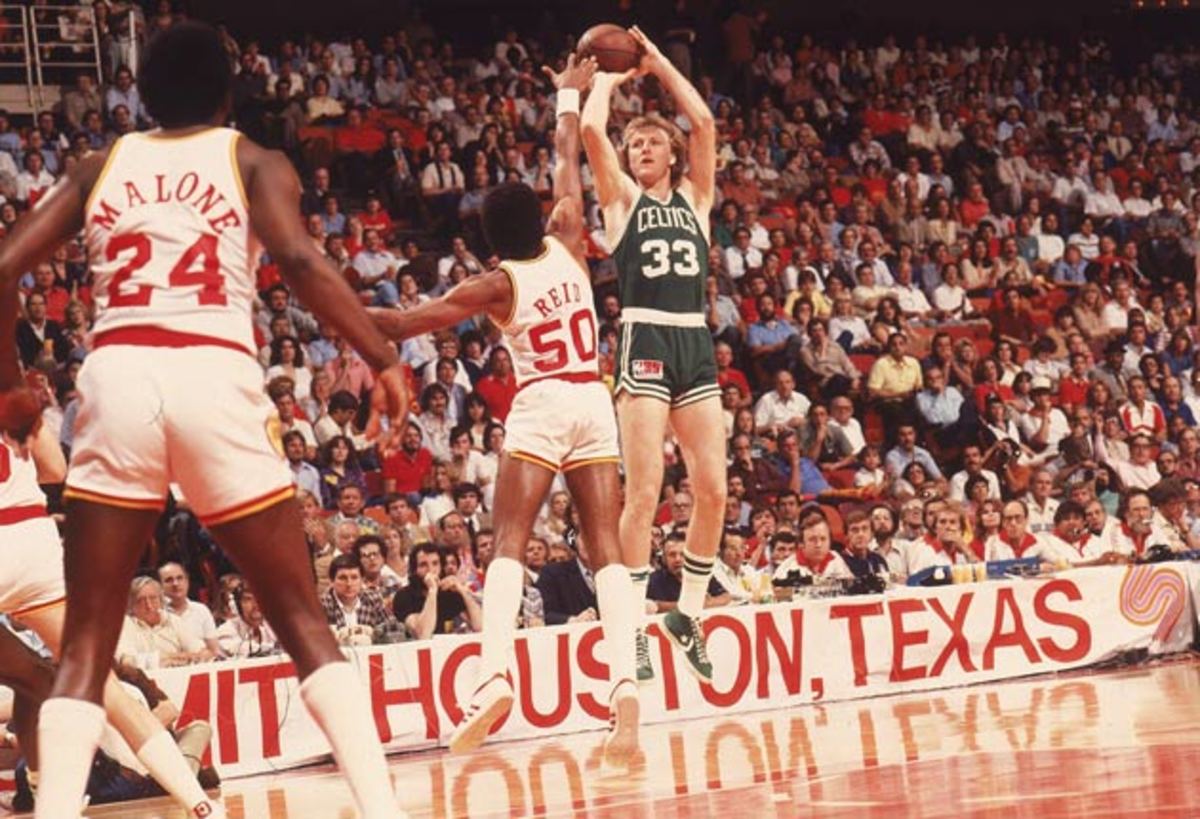
Shooting
Above all, it is Bird's ability to hit a shot under pressure that makes him great. Scott Wedman may beat him in H-O-R-S-E now and then, and Ainge took him for $35 in a game two weeks ago in Seattle, but turn on the TV lights and put 15,000 hostile fans in the seats and Bird has no peer. His winning 18-of-25 performance in the three-point field-goal contest on NBA All-Star Game weekend proved that. "When I found out Birdie could make 10 grand shooting baskets in one afternoon," said McHale, "I knew it was all over."
Bird does take—and miss—many low-percentage shots, horrible shots that would earn a lesser player pine time. But that is part of his game, part of his aura. He is constantly communicating the idea that he can do anything out there, and indeed, some of his off-balance uglies go in. "I'm like a gymnast," says Bird. "I'm into degree of difficulty."
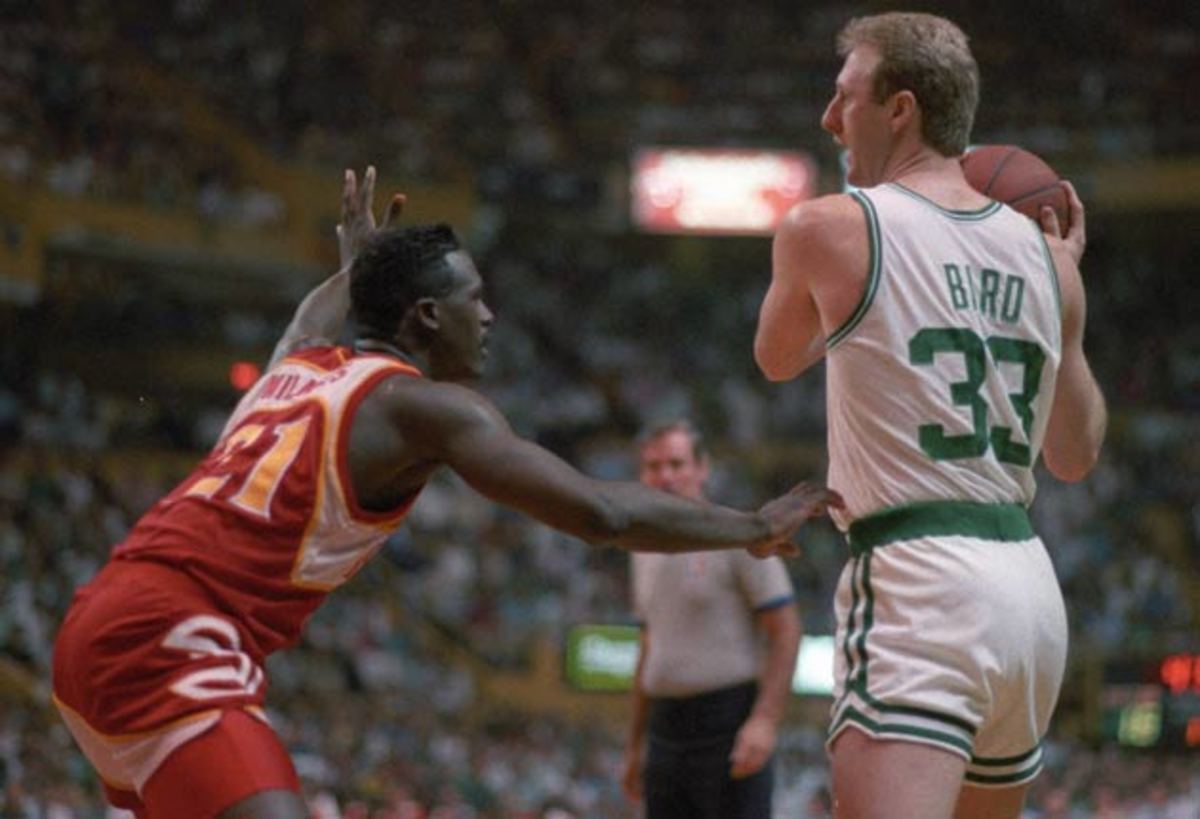
Pump fakes and step-backs
No one has as many moves to set up a shot as Bird. "Sometimes I fake myself out," he says. But that's rare. Says Wedman, "Larry makes the defensive man play him. After a while, his man doesn't know whether he's coming or going." Bird's quick release and set-shot motion make possible his moves—his actual shot looks just like his ball fake. "I think the key to his repertoire is his step-back move," says Clipper assistant Don Casey. "He opens the distance between himself and his defensive man very quickly. Then the defensive man steps up even more quickly to close it, gets off-balance, and Bird's around him." Indeed, when Bird goes into his assortment of fakes, he often leaves a trail of defenders who look like they're in a pogo-stick competition, as he did last week against the Warriors when he got Purvis Short, then Larry Smith up in the air before going around them both to score.
Ambidexterity
By unofficial count, seven of Bird's 21 field goals against Portland on Feb. 14 were shot with his left hand. Newell calls his ability in that area "phenomenal." San Antonio's David Greenwood, a former Bull, remembers a game in Chicago in which Bird was calling out his wrong-handed shots. " 'Left hand, left hand,' he kept yelling," said Greenwood. "And he hit everything, including a lefthander while going out of bounds." Bird does eat and write with his left hand, but so do many other athletes (teammate Bill Walton, for one) who don't have Bird's lefthanded athletic abilities. The simple truth is that he has worked long and hard developing a lefthanded shot, and the awful truth for opponents is that he's getting better at it.
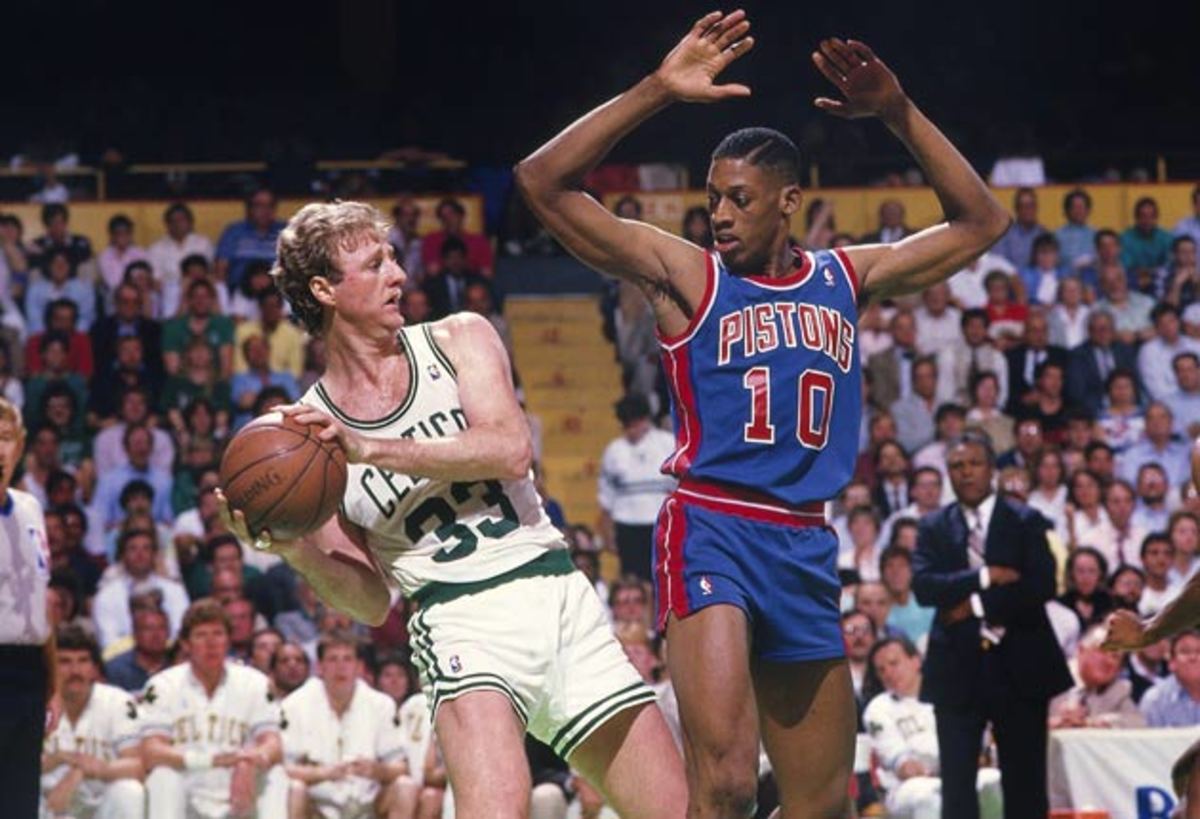
Passing
Can there be any doubt that Bird is the best passing forward in history, better even than the creative Rick Barry? No, says Newell. "He's got to be one of the best passers of all time, including guards. You can't teach what he does." In an open-court fast break, Magic Johnson is still more effective, but in most other situations the nod goes to Bird. Lately, without the injured McHale in the Celtic lineup, Bird has been doing a lot of posting up down low, getting the ball and deliberately, very deliberately, drawing players over to himself before he zips the ball crosscourt to Dennis Johnson, Ainge, Wedman or Jerry Sichting for the open jumper. Or he'll try the exotic. Against the Warriors, possibly in one of his bored moments, he drove slowly to the corner and picked up a triple-team. The next thing Walton knew, the ball was coming to him from between Joe Barry Carroll's legs. "I'm not sure how I did that one myself," said Bird. Says Cousy, "I think we could both throw, not the unorthodox pass, but the unexpected pass."
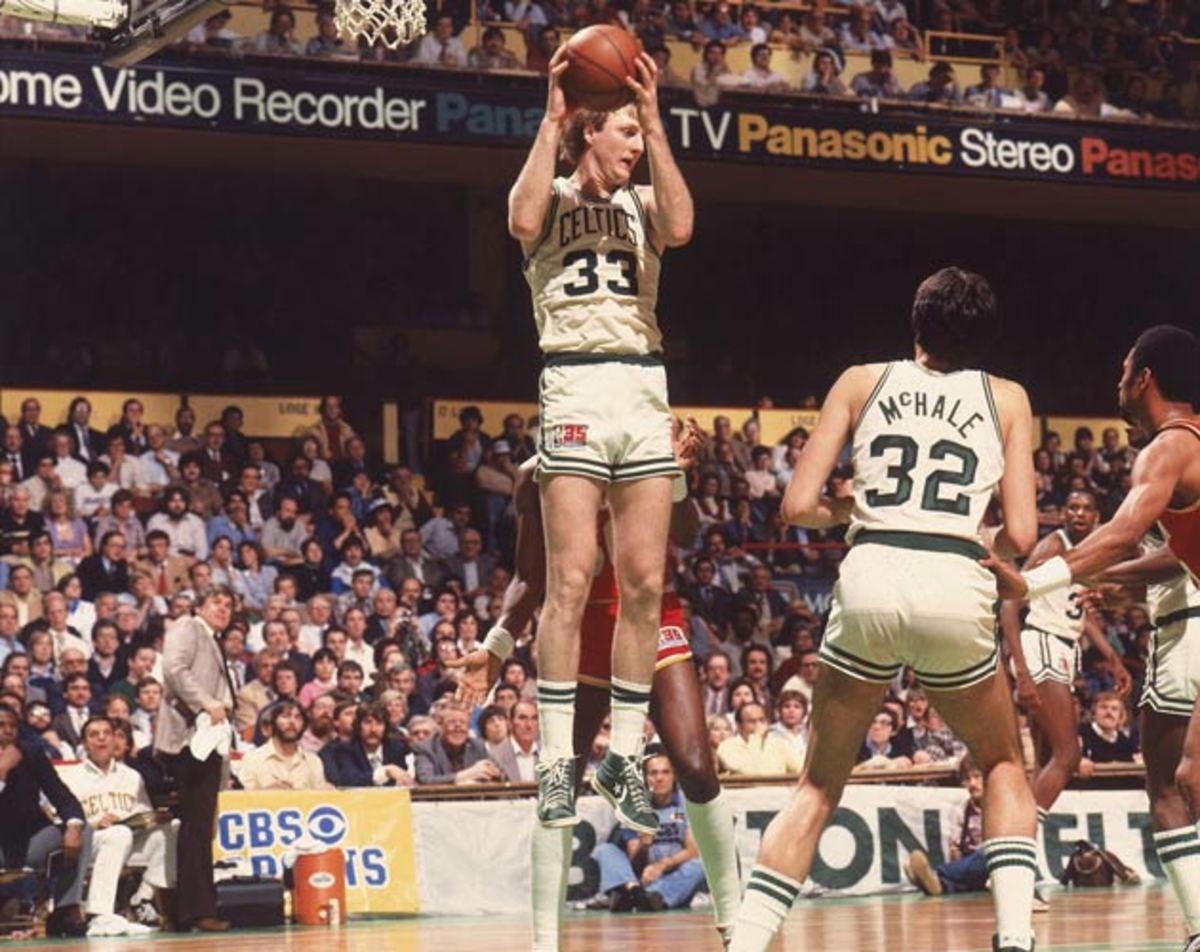
Rebounding
Two of the most fierce rebounding forwards in NBA history are Paul Silas and Maurice Lucas, both with career averages of 9.85. Bird is better. Hard to believe, isn't it? McHale says, "The key to his rebounding is the strength in his hands." Newell: "He epitomizes what you try to teach—position, getting the ball at its highest point and going forward when you get the ball." Bird: "Most rebounds are taken below the rim. That's where I get mine."
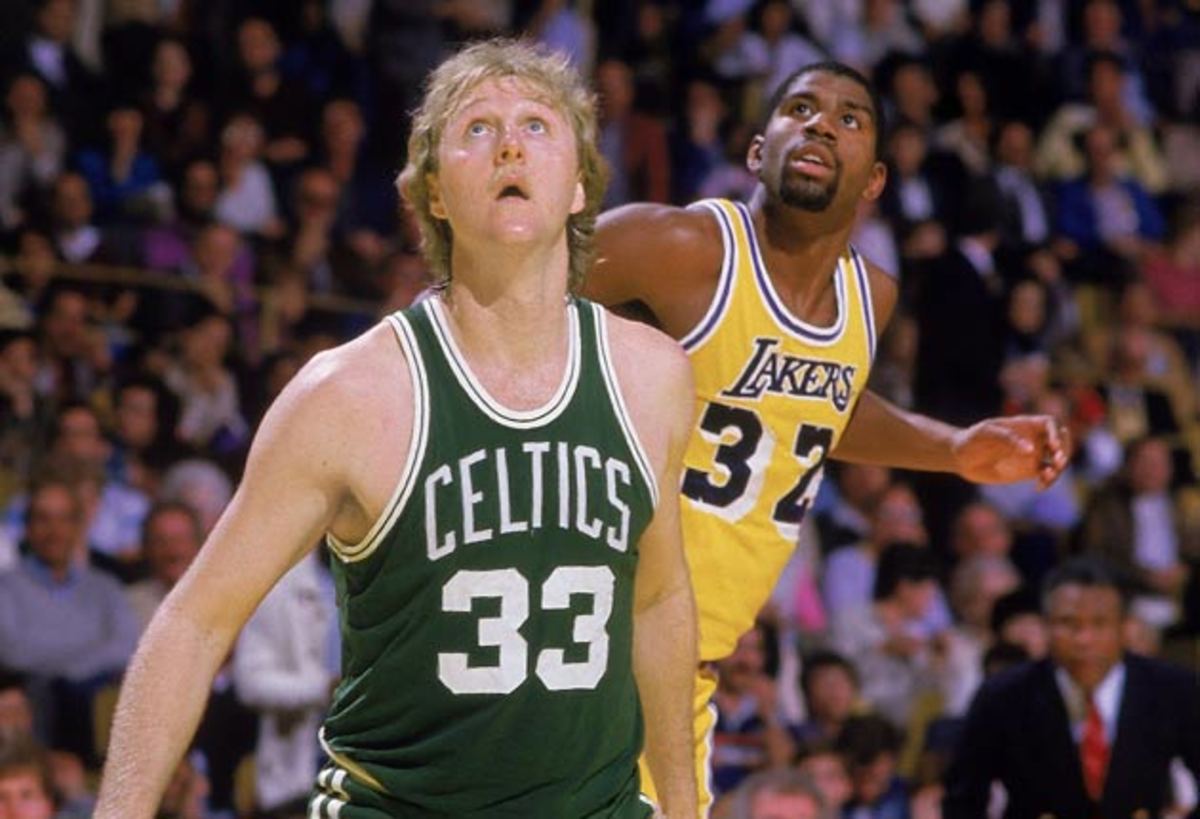
Performing in the clutch
One comment from Auerbach says it all. "The best I've ever had in rising to the occasion were Cousy, [John] Havlicek and Russell. And Larry goes beyond them in that particular phase of the game. He wants the ball, and he knows what the hell to do with it."
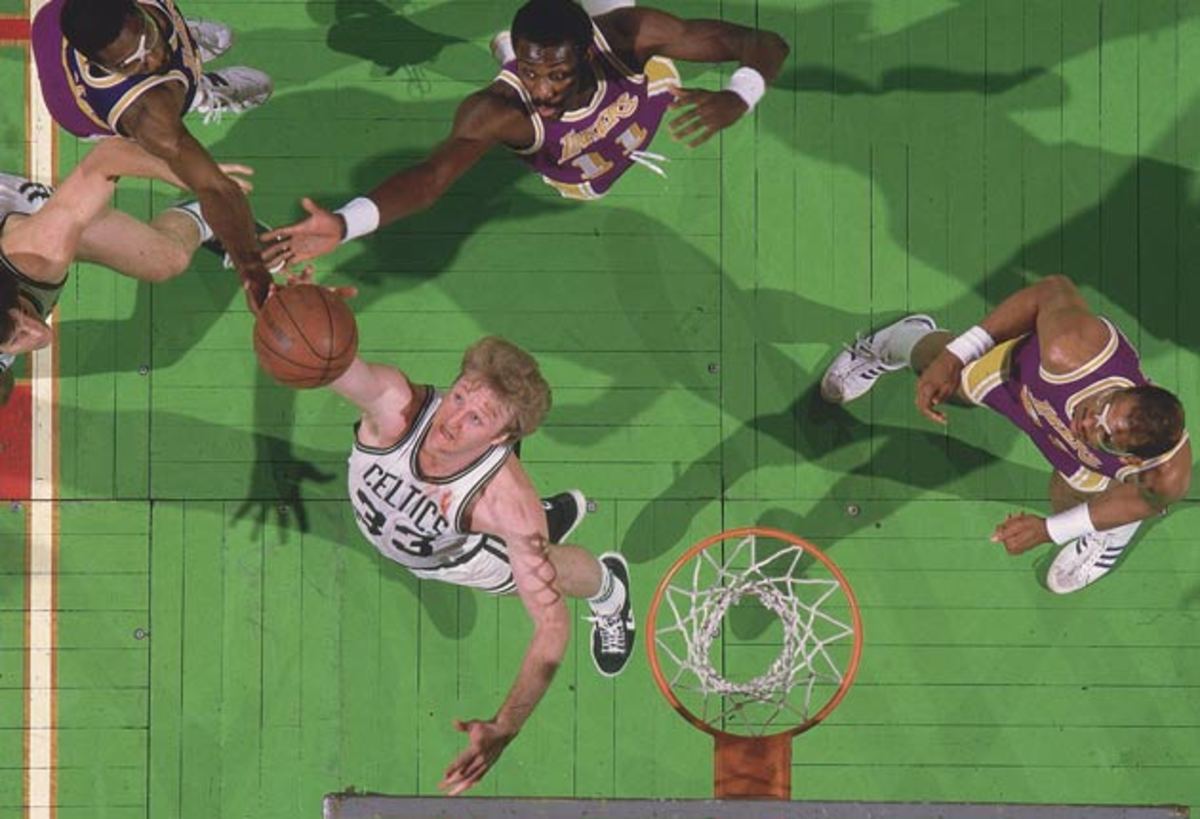
Playing hard
Here's a sequence from the first half of last week's Celtic-Nugget game. Bird, the lone defender on a three-on-one Denver break, deflects a pass. He dives to the floor, comes up with the ball and, from his knees, tosses to Wedman to start a Celtic fast break. "Look in his eyes," says Atlanta's Dominique Wilkins, "and you see a killer."
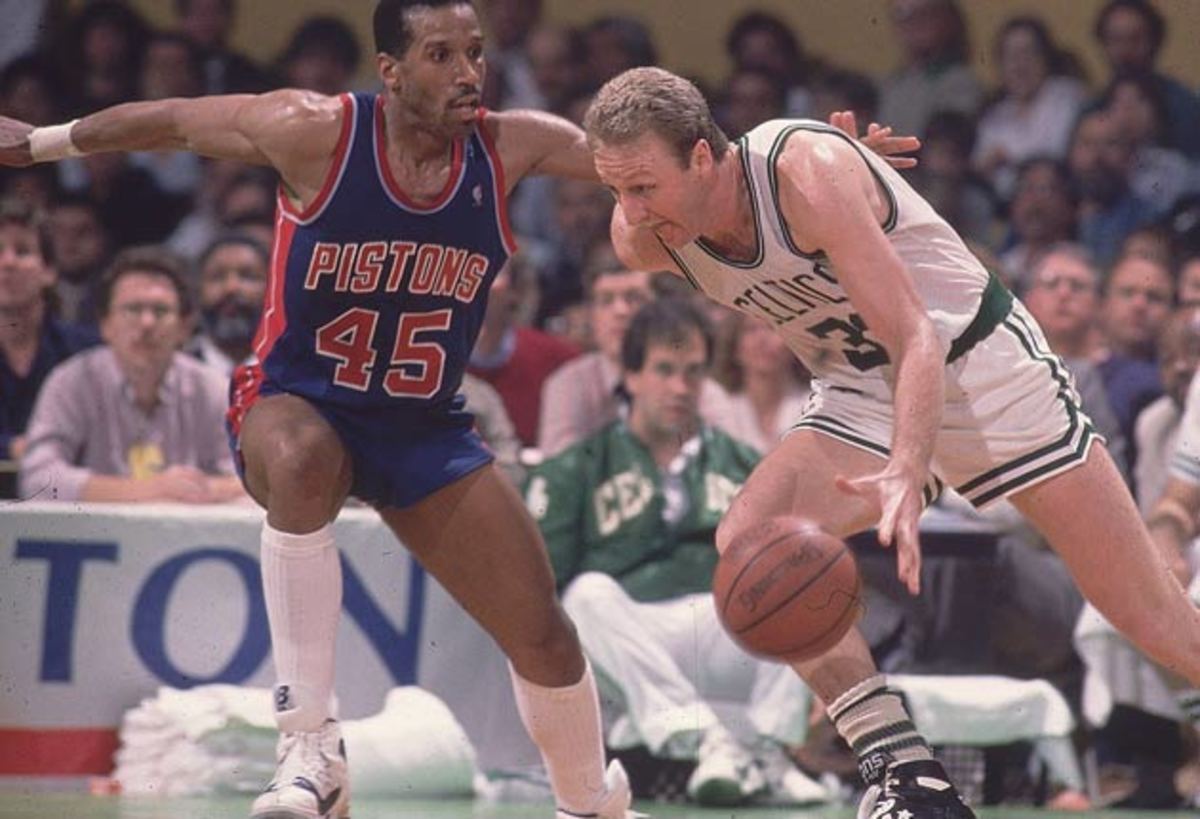
The mental game
Piston coach Chuck Daly remembers Bird drilling a jumper in front of the Piston bench two seasons ago, then stepping back and "knocking me ass over tin cups. I think he did it purposely. He's just a tough guy. He has almost the perfect attitude." Even before he made 11 straight in the three-point shootout at the All-Star Game, Bird, in all likelihood, had the contest won in the locker room when he told the seven other competitors, "All right, who's playing for second?" When your boasts are empty, you're a weenie and a stiff. When you back them up, you're a legend. Bird has become a legend.
At this point Bird seems unconcerned with reserving a throne in the NBA pantheon. He never saw the great forwards of the past, the Baylors and Bob Pettits—Schayes to him is the Nuggets' Danny, not the Syracuse Nationals' Dolph—and has watched only a few film clips of Barry, a superstar of more recent vintage. "All I know is that people tend to forget how great the older great players were," says Bird. "It'll happen that way with me, too." He has never been much of a student of history and, anyway, today is looking pretty bright. He's the epicenter of a winning team, a happy team, a loose team.
"I can still see Larry getting on the bus after a shoot-around," remembers teammate Rick Carlisle, "and saying, 'Well, we just got done shooting basketball. Now it's time to go to our free hotel, have a free meal, then play the game. It's a tough life.' To Larry, this is special. He loves it. He couldn't imagine doing anything else."
"He is happy playing basketball," says McHale, "but one thing I know is that you won't see Larry in his 15th season getting 20 minutes. And you shouldn't. I don't want him to be the Everly Brothers, just hanging around after their prime. Larry Bird is like Elvis. He's got to get out while he's the King."
Bird, who after this season will have four years remaining on a contract that pays him $1.8 million per year, has thought about the end. "I feel that I could play six more years at this level," he says. "But it'll probably be four. Red said that after that period of time, 10, 11 years, you tend to lose it. And I know I don't want to leave with a lot of pain." Then he shrugs. "Of course, maybe what I should tell Red is that I'm different than a lot of people he's coached."
This story originally ran in the Mar. 3, 1986 edition of SI. To subscribe, click here.
